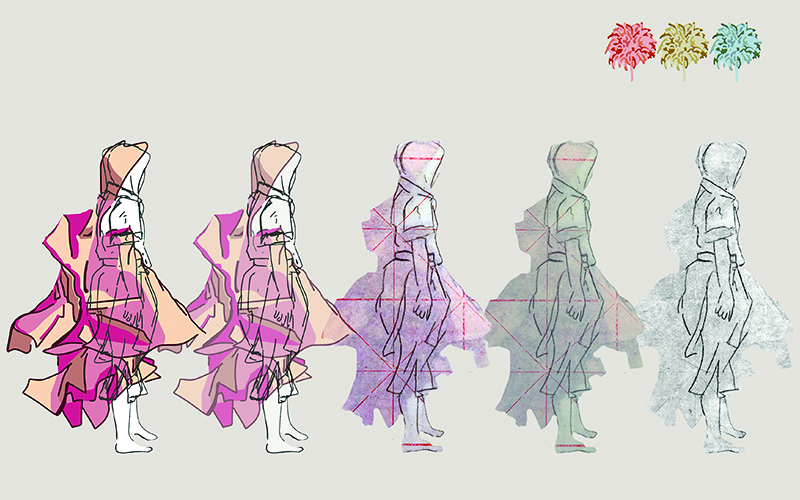
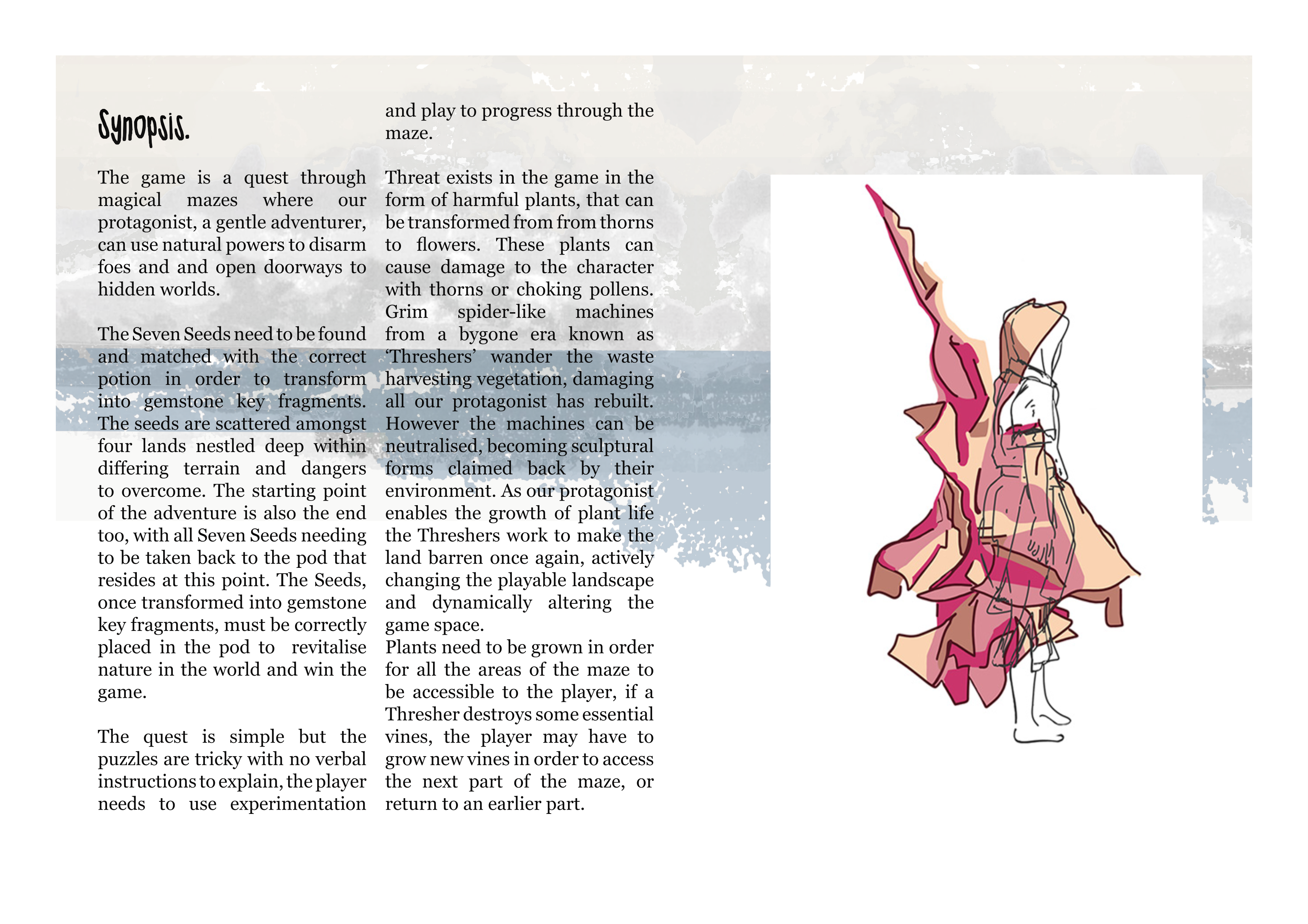
Watch the pitch as a slideshow.
An animatic of gameplay.


Watch the pitch as a slideshow.
An animatic of gameplay.
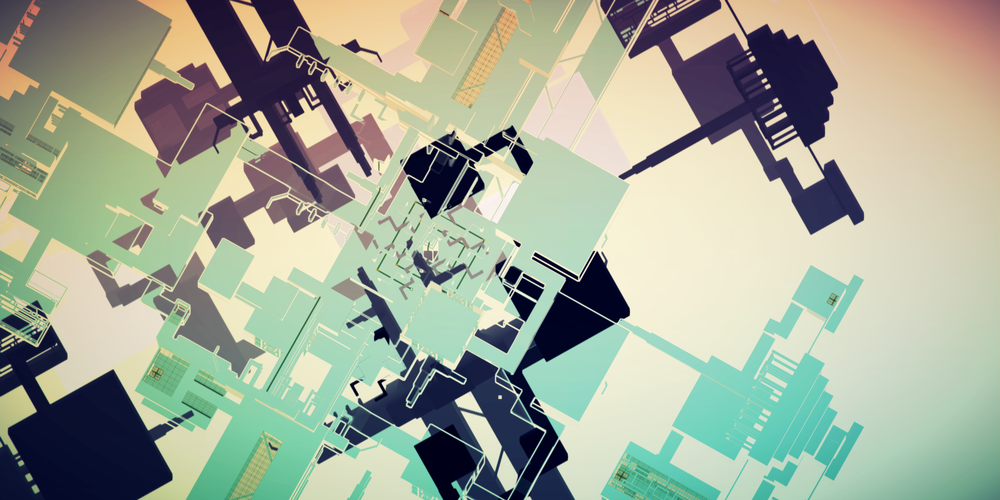
Concept artists and games designers William Chyr and Matt Nava are concerned with combining research and videogame design. Their creative activities are founded in theoretical research including scientific, experiential and academic enquiry. This is and installation called ‘Ondine, The Happiness Project, October 2011’. It is by William Chyr who researches the intersection of art and science. He has recently released a videogame called ‘Manifold Garden’. A puzzle game that subverts physical laws enabling the player to navigate space in an abstract and theoretical way.
Chyr, W., (2013), ‘On the intersection of art and science’. Blog page.
Available at: williamchyr.com/on-the-intersection-of-science-and-art/

Indie videogames are pioneers of exploring the connections between videogames & art, videogames & politics and videogames & philosophy. In the videogame ‘Ennuigi’, by Josh Millard, the player is Luigi in a post apocalyptic Mushroom Kingdom. Moving the character between ever changing screens smoking and wondering through an inner monologue of thoughts and regrets. This is an example of how videogames are inventively telling meaningful or political stories through devices such as self-referencing.

In researching the structure of videogame design, particularly game play, I have been looking at patterns. Anni Albers’ Notebook from 1970 to 1980 is full of hand drawn pattern and plans for textile weaving. Visually the flatness of the drawings relate to flat planes of platform videogames.
The role of visual arts and the connection with videogame is a current debate in concept art and illustration. Questions of how videogame relates to the cannon of visual art history and context is under discussion by a number of academics, game developers and creative practitioners including the designers, authors and lecturers, Eric Zimmerman & Ian Boggost, curator Kristian Volsung, and Chicago based art gallery the VGA (Video game art gallery) which ‘seeks to increase cultural appreciation, education of video games and new media through exhibition, study (and) critique’.
“The tectonic is both the expression of the monumental reminders of the distant past, some, in the case of the cathedrals for example, still surrounded by the ancient rites of a hierarchical and dogmatic formal system, and at the the same time, challenge to individual creation on the threshold of the new reality to come (the cathedrals yet to be built).” (Zeidler. 2010 ).
If Bataille’s terms in Documents were Formless, Architecture, The Human Body, Animal and Low then, for comparison, the terms his collaborating editor Carl Einstein preferred were:

Connor Joyce, from ‘A Play of Concepts’ Chapter 3 of Carl Einstein in Documents and his collaboration with Georges Bataille., p.45.
In an analysis titled Play of Concepts, Connor Joyce compares the differences he finds in Bataille and Einstein’s critical theories during their collaboration in Documents. Where Bataille was concerned with the irrational Einstein was concerned with productive revolt. (Zeidler. 2010). Or more specifically metamorphic revolt. It was in metamorphosis where Einstein found the tectonic. ‘Einstein sees the tectonic as capturing … multiple levels of reality in one formal expression’. (Quigley. 2007). Einstein illuminated the tectonic through his critical descriptions of Cubism. For Einstein Cubism represented the layering of gestalt images. Images that, although in stasis, were ultimately ungrounded, had no foundation. Later, during Documents Einstein critiqued the work of Masson and Klee, which allowed him to develop the tectonic. Masson and Klee’s work were diagrams of something ‘truly metamorphotic’ (Zeidler. 2010), where the image passes from nothing to something then to nothing again, where the viewer is passive, becomes active through recognition and then passive once more. This process of metamorphosis Einstein called hallucinatory. This, believes Joyce, is the dialectic of Einstein, the binary opposition of the tectonic (the convergent) and the hallucinatory (the divergent). The tectonic seized the slippage, it is the ‘arrestment of flux’. (Zeidler. 2010), and the hallucinatory metamorphosis created fluidity. Reality, the real, is in the tension the duality creates. ‘Diagramming the metamorphosis of form on canvas, an affective artist enacts the metamorphosis of human subjectivity within the real’. (Zeidler. 2010).
The real was not a present human consciousness or experience. Rather, for Einstein, realities were within the mechanisms of interaction. Interaction between the viewer and an image was a reality, interaction between individuals became another reality, and so on. ‘The real in Einstein is the very alternation between realities and counter-realities’. (Zeidler. 2010). James Paul Gee writes similarly, “As people are simultaneously members of multiple lifeworlds, so their identities have multiple layers that are in complex relation to each other. No person is a member of a singular community. Rather, they are members of multiple and overlapping communities.” (Gee. 2007. 71). Therefore could the multiple overlapping identities and interactions aligned with temporal grided images provided by videogame be tectonic?
The terms of Einstein’s dialectic (Joyce. 2003) could be employed to analyse the space of videogame within the conceptual capacity of the tectonic if used as the parameters of a semiotic square:

A diagram composed to illustrate possible terms of videogame in the expanded field via the tectonic. Alice Nant (2020).
The expanded terms might be composed thus:

A diagram composed to illustrate possible terms of videogame in the expanded field. Alice Nant (2020).
Or in a Klein bottle the diagram expands to include:
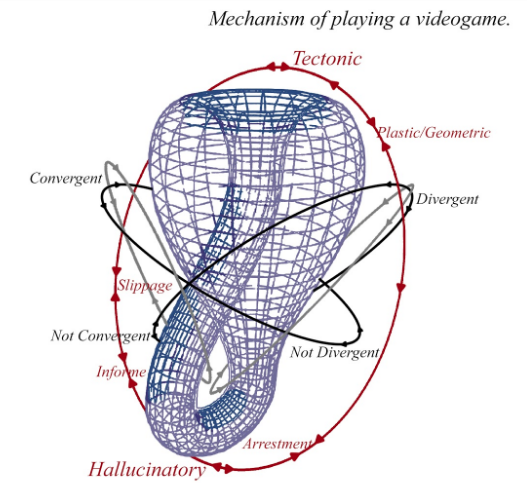
By using a structuralist Kraussian analysis to negotiate the concepts and navigate the terms, there is certainly a suggestion that videogame may be tectonic. An example of a tectonic videogame is Hyper Light Drifter. It is a multiplatform two dimensional role play game. Aesthetically and through the gameplay, the design references 8 and 16 bit games from the early 1990’s. Movement is constructed using up, down, left and right commands, such that to move away, further into the games environment the command is up, to return, to move back out of the game the command is down. Progression through the game relies on moving through framed spaces with the illusion of height and depth. The ground shifts, shudders and falls away during movement through the spaces. The environment is statically fluid, stable but ever changing. The spaces are filled with beautiful coloured forms and figures, but also charged with horror and nightmare. The game is without written or verbal instruction, and the objective of each part of the game is discovered through patterns and symbols.


If videogame is tectonic, then the space it offers is what Einstein called ‘the real’. Hyper Light Drifter demonstrates many of the elements of the tectonic, and the mechanism of playing the game can be explained using the Klein bottle experiment in Figure 15. This passage from Zeidler reflects the experience of the videogame. “On the one hand, the real is liberatory. It ensures that something like history is possible at all. It enables us to transgress the given and produce new realities … On the other hand, the real enables the transgression of our realities by others in turn. Our freedom and our mortality, the very possibility of new worlds as well as their radical impermanence, go together.” (Zeidler. 2010).
Another example of videogame that equally illuminate a tectonic analysis are Superbrothers Sword and Sorcery. Also a role play adventure game which uses similar mechanics moving through framed spaces and landscapes, although the territory does not shift in the way experienced in Hyper Light Drifter. The landscapes are differently transformative with yawning faces in rocks and crumbling ruins of previous civilization.

Carl Einstein understood ‘the real as a nonhuman structure of the human interaction with one another and with their world history’. (Zeidler. 2010). Einstein’s context was early twentieth century painting. Videogame, a ‘new’ medium, can equally be described as a nonhuman grid and a language structure within which to experience human interactive realities.
In Summary.
“The narrative and formal cannon [of the tectonic] transmits not only past subjective experience and affection but also the dynamics and power to govern contemporary reality”. (Quigley. 2007).
In this paper the tectonic is understood as an experience that enables a structured visual language to exist and be understood in the same moment as an engagement in subjective flux. The mechanics involved in the tectonic resonate deeply with the mechanics of videogame. This study has also presented evidence that there is potential in videogame to be a space for the purposes of art and illustration.
“A dictionary begins when it no longer gives the meanings of words, but their jobs.” (Bataille via Krauss. 2004).
“It is neither the ‘form’ nor the ‘content’ that interests Bataille, but the operation that displaces both of these terms. In this operation of slippage we see … what Bataille calls the informe”. (Bois. 1997).
Fredric Jameson had a theory where an art object was produced as a solution, but the problem to this solution was reasoned by the critic. The producer of the art text as problem solver, as creator of a solution, and the reader as problem maker, as the author of reason. Jameson reasoned that through the analysis of a creative text a collective political unconscious is uncovered. This unconscious rests between the signifier, the text, the solution and the signified, the critique, the problem. Therefore meaning exists somewhere in the space between the axiom and the idiom, the truth and its communication. Jameson was concerned with mapping the onset of postmodernism by basing it in history, tracing a horizontal story through the vertical logic and a-history of modernist ideology. Jameson’s book ‘The Political Unconscious’ was published in 1981. Two years earlier Rosalind Krauss’ paper, ‘Sculpture in the Expanded Field’, was published in the journal October. As a contemporary of Jameson, Krauss was also concerned with the mapping of postmodernism, she stated that it was “extremely important to map” the shift into postmodernism. (Krauss. 1978. 290). She did this by focussing on sculpture and used the Greimas or the Semiotic Square as her map. The square is a mechanism for expanding two opposite or binary ‘positive’ concepts by illustrating the relationship with their ‘negatives’. For instance:
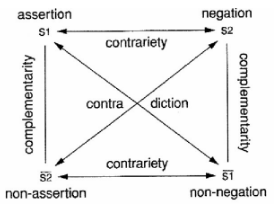
Source: Chandler, D; (2002). Semiotics: The Basics. London: Routledge.
For Sculpture in the Expanded Field Krauss set the positive concepts as landscape and architecture, and the negatives as not-landscape and not-architecture. In the spaces surrounding the square she found room between the terms to place site-construction, axiomatic structures, sculpture and marked sites. (Krauss. 1979. 284). Thereby ‘expanding’ the notion of sculpture beyond an object on a plinth. A contemporary of Krauss, Hal Foster, quotes Jameson’s opinion on the use of the semiotic square, he wrote that the diagram ‘constitutes a virtual map of conceptual closure, or better still of the closure of ideology itself, that is, a mechanism which, while seeming to generate a rich variety of possible concepts and positions, remains in fact locked into some initial aporia or double bind that it cannot transform from the inside by its own means.’ (Marshall. 2015). Jameson indicated that the semiotic square is a vertical mechanism which disrupts the continuity of his historical, horizontal and narrative mapping of postmodernism. Although both structuralist in approach, Krauss’ methodology is at odds with Jameson’s. If Jameson’s theory was put into a semiotic square, it might look something like this:
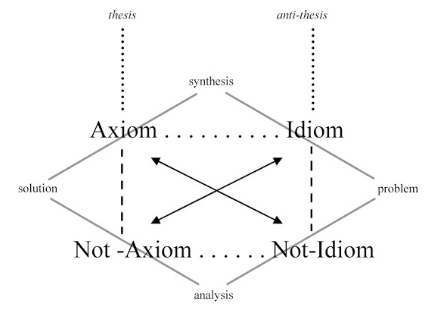
A diagram I composed to illustrate what Jameson’s theory might look like ‘expanded’. Alice Nant (2020).
This exercise of squaring Jameson aims to illustrate the use value in Krauss’ method of mapping. Much criticism has been levied against her use of the square as reductionist and interior. Hal Foster stated that the binary and oppositional nature of the square, although useful for identifying space, refused linear change and development as it did not accept what was outside. (Marshall. 2015). By expanding Jameson’s art-text-as-solution (axiom) and critique-as-problem (idiom) it could be proposed that the square can be used as a location from which to explore beyond its boundaries the implication of which, I hope, validates the use of Krauss’ expansion map for the purposes of illuminating the spaces of videogame.
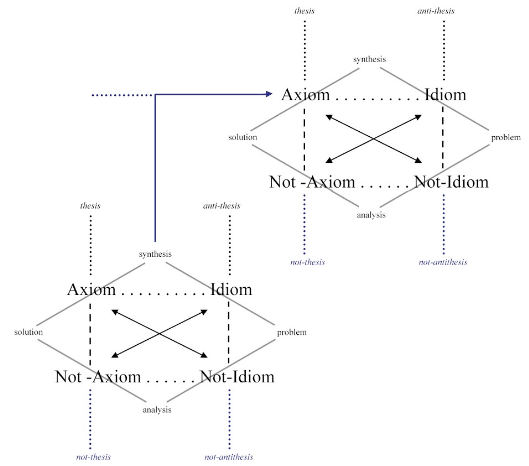
A diagram I composed to illustrate what Jameson’s theory might look like ‘expanded’ beyond its boundaries. Alice Nant (2020).
In order for the semiotic square to explore beyond its boundaries, a temporal element is required. Such that both mapping devices, the horizontal narrative and the vertical logical, co-exist. A more elegant diagrammatic analysis than mine above has been performed by the architect Sandro Marpillero in his review of Retracing the Expanded Field. Retracing the Expanded Field was a roundtable seminar event involving Rosalind Krauss, Yve-Alain Bois, and Benjamin Buchloh, moderated by Hal Foster, held at the Kitchen, New York in 2014. A book containing the papers, the discussion and academic responses and reviews was published in 2015. The diagram used to illustrate the coexistence of vertical and horizontal is the Klein bottle.

A diagram of a Klein Bottle by Patrascu, A., (2015). The mapping of non-planar diagrams into planar diagrams. www.researchgate.net/publication/272171964_The_mapping_of_non-planar_diagrams_into_planar_diagrams_and_the_exact_solution_of_QCD
Marpillero states “As a basis for producing conceptual figurations in space/time, the operational logic of the Klein Bottle not only describes the reciprocal exchanges between a participant in an aesthetic experience and the multiplicity of techniques structuring that experience. It also addresses the open-ended processes embedded in the production and realization of an architectural project.” (Marpillero. 2015). He asserts that combining horizontal and vertical into the bottle diagram releases the semiotic square from two dimensional boundaries by intersecting through, between, above and below.From Jameson we understand that development is horizontal, and from Krauss that it is vertical. We have also seen that horizontal and vertical transformation can be combined, in an expanded square or, as in Marpillero’s experiment, using the Klein bottle. This notion has echoes of Grids, a paper by Krauss published at the same time as Sculpture in the Expanded Field. Krauss wrote that ‘There are two ways the grid functions to declare modernity … One is spatial; the other is temporal” (Krauss. 1979. 9). She describes the grid in terms of its flatness, its geometricity, and its ordered rejection of nature, mimesis and of the real. In these terms the grid serves as the archetypal vehicle for modernist visual production, such as can be seen, she suggests, in Mondrian and Albers. The paper develops however, to demystify this statement, by describing the grid not only as spatial with vertical and horizontal axes, but also encompassing temporality. The temporal movement of the grid was characterised by Krauss as centripetal and centrifugal. This description imagines the movement of the grid as spiraling from the boundaries inwards, and in reverse spiralling from the centre beyond the frame into real space. She states that the grid in its bivalence is ‘fully, even cheerfully, schizophrenic’. (Krauss. 1979). By this she meant that the grid (Videogame, by virtue of it pixelated form, is in fact a grid) undermines its own logic as static form that becomes movement, it is a reproduction of the real, of itself in real space, onto itself. It is its future and its past. If the schizophrenia of the grid is its use of temporality to undermine its own logic, then logically the grid is formless.
The suggestion that the grid is time-based, or four dimensional and not a fragment of a two dimensional plane, allows it to move forwards and backwards, through itself and back again, through time. A function that might be called formless. Formless, or l’informe was a conceptual mechanism of Georges Batialle. Using l’informe Bataille defended his critical position against the purity of aesthetics, academia and humanity seemingly inherent in art in the first part of the twentieth century. A formless, slippery, concept employed to disrail art and destroy its elevated positioning as truth. Terms often used by Bataille Documents:

Connor Joyce, from ‘A Play of Concepts’ Chapter 3 of Carl Einstein in Documents and his collaboration with Georges Bataille., p.45.
A Bataillian outlook could be useful for critical analysis of certain videogames such as Ennuigi.
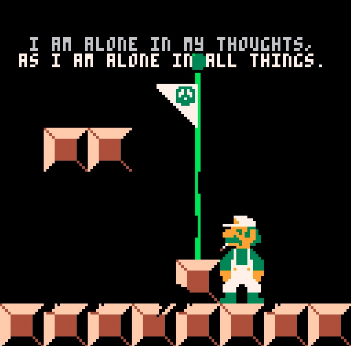
Millard, J. (2015). ‘Ennuigi’. Web Browser. Lexaloffle, Tokyo, Japan. https://www.lexaloffle.com/bbs/?tid=2232
The image above is from indie game Ennuigi. Luigi, famous brother and plumber, wanders around an apocalyptic Mushroom Kingdom. The controls for Luigi are left and right, smoke and ‘speak’. Each phrase appears in type at the top of the frame and consists of an introspective, depressed, sometimes regretful, sometimes nihilistic sentiment. For example, “I look at a turtle, I think I have done you one better. You wear a shell. I have become one.” (‘Ennuigi’. 2015). The player moves the character from one screen to next deciding whether to smoke or to speak. Josh Millard, Ennuigi creator, states, “this is one lens through which to look at … Luigi, the … complicit onlooker, wandering now through some fractured, rotting liminal place in this strange world, reflecting on it all in scattered fragments.” (Millard. Via Pescovitz. 2015).Could games like Ennuigi be described as formless? Krauss wrote that the opposite of form is chaos, not formlessness (l’informe). ‘Instead’ she writes, ‘let us think on informe as what form itself creates, as logic acting logically to act against itself.’ (Krauss. 1994).
In his review of the exhibition of collages involving, among others, Arp, Duchamp, Ernst, Mirò, Magritte, Man-Ray, and Picasso, at the Galarie Goemans in Paris in 1930, Carl Einstein posed the question “Painting as a language. Why not?” (Einstein via Rumold. 2004). A central theme of Einstein’s theories on modern art, on image making, and more specifically painting, was concerned with visual language. By understanding the cubist flatness of Picasso and the abstract forms of Mason as visual language, Einstein enabled a theory of distinction for modern painting from narrative painting and thereby secured a release from the ‘primordial image’. (Rumold. 2004). Clearly Einstein saw that contemporary paintings were different from what had gone before, but he did not view modernity as a pure or original form of art, as we might understand by the formalist theories of Greenberg. Neither did his view prefer one over the other. Moreover, he understood the limitations of modernist devices such as the grid and its antinarrative stasis, and is perhaps, ‘the earliest critic of the avant-garde cult of (and myth of) purity’. (Rumold. 2004).
By asking his question Einstein is encouraging the reader to perform a visual turn, to consider painting as a language separate from literature and from narrative. To consider an aesthetic visual language, which creates a space for painting, or image making, to become its own entity. Georges Bataille, Einstein’s collaborator and co-editor of the surrealist magazine Documents, was similarly ‘driven by the desire for a spontaneous opening of the image space as an alternative experience’. (Rumold. 2004). As a night time breeze that blows open a window, ‘un coup de vent nocturne qui ouvre une fenêtre’. (Joyce. 2002). Documents was written and published between 1929 and 1930, whilst modern art was in its infancy. Ninety years later, with videogame as a medium also in its infancy, could we ask the same question, Videogame as a language. Why not?
Ian Boggost is an academic and videogame designer that has suggested a need for a new rhetorical domain for videogame. He has stated that the visual expression of art, a ‘visual rhetoric’, can help formulate a ‘procedural rhetoric’ for videogame. ‘Unfortunately, many efforts to unite computers and rhetoric do not even make appeals to visual rhetoric, instead remaining firmly planted in the traditional frame of verbal and written rhetoric in support of vague notions of “the digital.”’ (Boggost. 2007.) What Boggost is suggesting is that videogame, a visual medium, has more involved procedures than other visual means of production and requires not just a visual rhetoric, but a procedural rhetoric. In videogame constructed images are selected and sequenced in order for the images to function as purposeful methods for player interaction. Boggost’s objective appears to be to reinvent or expand a theory of visual rhetoric for videogame or ‘a new medium’. (Boggost 2007). Perhaps Boggost is teetering on the edge of a turn. From verbal and written rhetoric, to an image led procedural rhetoric similar to Einstein’s visual turn from literature.
Professor of education James Paul Gee writes about videogaming in a linguistic framework, in the introduction to his book ‘What video games have to teach us about learning and literacy’ and references Wittgenstein in terms of the impossibility of existence outside language, or an agreed set of rules. Gee views videogame in terms of a multimodal literacy, with various semiotic domains each with an internal and external grammar. The internal grammar is the designers and producers, with story, process and patterns. The external is the players. Gee asserts that the external grammar manifests in the forms of critical discussion through the social media interactions of gamers. Critique is essential to the public establishment of an art text, however the I feel external grammar could be more closely aligned with Boggost’s implied turn. That the player/user/audience through their understanding of visual language and their individual contexts, read the work, the videogame, and create their own meaning. Here there are parallels with how an audience reads or experiences visual communication through art or design. Gee describes this as more complex in videogame, comprising of “six design elements in the meaning-making process: those of Linguistic Meaning, Visual Meaning, Audio Meaning, Gestural Meaning, Spatial Meaning and the Multimodal patterns of meaning.” (Gee. 2007. 65). These design elements form what Gee describes as a ‘multimodal space’ which is the videogame space where a player interacts with the creative work. His theory is based on the notion that the player is the receiver of design patterns and conventions which connote meaning and simultaneously designs the meaning through interaction, by playing the game. This player function of simultaneous connotation and denotation, I propose, is an alignment with Boggost’s ‘procedural rhetoric’, as his step beyond the visual. Perhaps then it is a turn to the multiliterate or multimodal and not a ‘visual turn’ that is in operation? “The challenge” Gee writes, “is to make space available so that different lifeworlds – spaces for community life where local and specific meanings can be made – can flourish. [A space to provide] members of subcultures with the opportunity to find their own voices.” (Gee. 2007. 70-71).
In answer to the question whether videogame has its own language and potential space for a distinct system of artistic communication, I believe that it does. In 1980, at the beginning of commercial gaming, videogame was being described as ‘schema’, that a player made sense of the game through interactive experience and referencing an individual ‘readymade store of similar occurrences and understandings’. (Douglas; Hargadon. 2001). Gee perceives this potential in terms of experiencing semiotic domains as ‘design spaces’ with which to engage, create, and promote problem solving and collaboration. Helping players learn ‘to experience (see and act on) the world in a new way’. (Gee. 2007. 37). Boggost asks us to recognise the procedurality of videogame in terms of persuasive expression and states, ‘As players of videogames … we should recognize procedural rhetoric as a new way to interrogate our world, to comment on it, to disrupt and challenge it’ (Boggost. 2007), and calls for the cultivation of responsibility and consciousness of procedural rhetoric.Visual communication is essential to the immersive nature of videogame. The game Gris is an example of the beauty available in the medium, with consideration of visual communication through form, colour and movement. This is true not only of standard console games, but also on mobile devices. For instance Lifelike available through Apple Arcade (2019) depends on the movement of the visual elements to create feeling through motion.

Nomada Studio. (2019). ‘Gris.’ Digital download. Mac OS, Microsoft Windows, Nintendo Switch, iOS. Devolver Digital, Austin, TX, USA. Source: gamewatcher.com/reviews/gris-review/13085
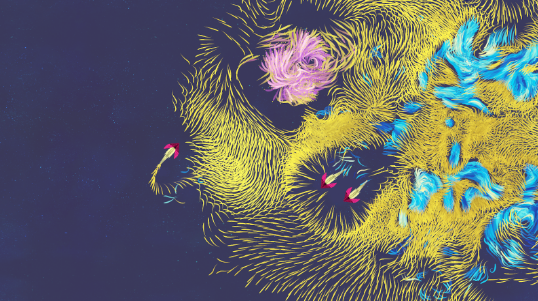
Kunabi Brother GmbH. (2019). ‘Lifelike’. Digital download. iOS. Apple, CA, USA. Source: lifelikegame.com/
James Paul Gee wrote that gamers, through videogame are “Learning how to think about semiotic domains as design spaces that engage and manipulate people in certain ways and, in turn, help create certain relationships in society among people and groups of people, some of which have important implications for social justice.” (Gee. 2007. 37-38).
The language of videogame is unique, it is an inherently visual, interactive and immersive dialogue and within this is potential for creativity beyond a traditional notion of gaming.
“The narrative and formal canon transmits not only past subjective experience and affection but also the dynamics and power to govern contemporary reality”. (Einstein via Quigley. 2007).
‘The Game FAVR’ FAVR: A Framework for the Analysis of Visual Representation in Video Games (2015) is a report researching the language of videogame. The aim was to review and formulate a language to enable an academic discourse for the medium. It was developed due to ‘a need to create a unified framework to analyze videogame images … that would account for the transformative and historical nature [of videogame].’ (Arsenault et.al. 2015). The term historical is used in relation to videogame development from an art historical context, in particular painting. The term transformative is referencing the potential of videogame to enable change. The paper suggests that currently videogame is discussed through an amalgam of borrowed terminology from art history, film and animation. The authors are concerned with creating and presenting a usable toolkit, a ‘unified framework of the ergodic animage, the rule-based and interaction-driven part of visual representation in video games.’ (Arsenault et.al. 2015). They have a structured methodology and aim to locate their research within the analytical game spaces first proposed by Micheal Nitsche in 2003.

Game Spaces. M. Nitsche’s five analytical planes. (Nitsche 2003. p.15). Source: threepartstheory.files.wordpress.com/2010/11/5planes.png
In Nitsche’s model ‘Players … engage in a constant dance between abstract problem-solving and partial suspension of disbelief by deciphering visual information, narrative propositions and game mechanics’. (Arsenault et.al. 2015).

Arsenault et al. (2015). ‘The Game FAVR: A Framework for the Analysis of Visual Representation in Video Games’. [online]. Loading… The Journal, 9.14. loading.gamestudies.ca
The Game FAVR researchers used Nitche’s model as a foundation from which to define their own set of game spaces or planes. In this diagram FICTION is game narrative, RULES the game mechanics and VISUAL MEDIATION the decoding of visual information presented by the game. All three planes together form the plane of intelligibility, or how all parts combine to enable the player to play the game. The paper exposes a linguistic structure of videogame, categorising it into internal and external occularizations. In terms of composition the authors categorise the space of videogame as ‘1. tangible space, 2. intangible space and 3. negative space’. (Arsenault et.al. 2015). In short, the document makes the case for videogame as language and so develops a methodology that can be used for critical analysis of videogame in terms of image, space, constraints and potential.

I worked on illustrating the story ‘Buffalo Gals won’t you come out tonight’ by Ursula K. Le Guin. The story evokes imagery through language moving the reader from real to unreal, employing the slippage of time and concept of inhabitated space and being. It is a short story, and I would aim to adopt the story into an illustrated narrative or graphic novel.
The story is full of magic and evokes strong feelings around motherhood, and the role of mother as protector and teacher, where grandmother is the wisest of all. The animals that feature in the tale are from native american stories. The tale enables the reader to assess what is real, what is known, against what is not real, what is only felt. Once emmersed in the unreal, the real becomes strange. “If the language we use to describe things has no meaning in the context we’re in, our understanding of things dissolves until there is nothing left but the basic elements of the thing, like iron and salt on our tongues.” (Fettig, 2012).
The story is of a girl that falls from the sky, from a plane flown by a man, flying her to her father. They sky is patriarchal. Myra falls from the sky into the world of the old ones. This is a world of female animals. When Myra sees through her left eye, her good eye, she sees animals. When the wound of her damaged right eye is soothed and replaced with a pitch eye, Myra sees people. Pitch eyes are a reference to a Native American origin story, where Coyote’s eyes got stuck in a tree and were replaced with pitch.
Seeing and naming are themes throughout the short story. Sight cannot be trusted to show Myra the real. Names are as slippery, and Myra adopts three names, Myra, Gal and Pup. The various names indicate a fractured identity, “Through an openness to viewpoints and communities outside dominant human cultural experiences, Myra becomes, and accepts the necessity of remaining … a “split and contradictory self”.” (Armbruster, 1996).
Karla Armbruster analysed the the short story in her paper A Poststructuralist Approach to Ecofeminist Criticism. Although twenty years old, the paper lays a foundation for further investigation into blurring boundaries of realities, such as in my interest reinventing the space of video games for illustration. Armbruster suggest the slippage found in the identity of Myra, “holds potential for subverting dominant ideologies because her divisions and contradictions allow her to connect without oversimplifying her identity in ways that reinscribe those ideologies in new forms.” (Armbruster 1996).
In terms of visual research I focussed initially on finding inspiration from Native American artists. I have discovered historical and contemporary paintings and drawings that use flat planes, shapes and block colours, which in many ways complement my own visual language. Artists I have discovered include:
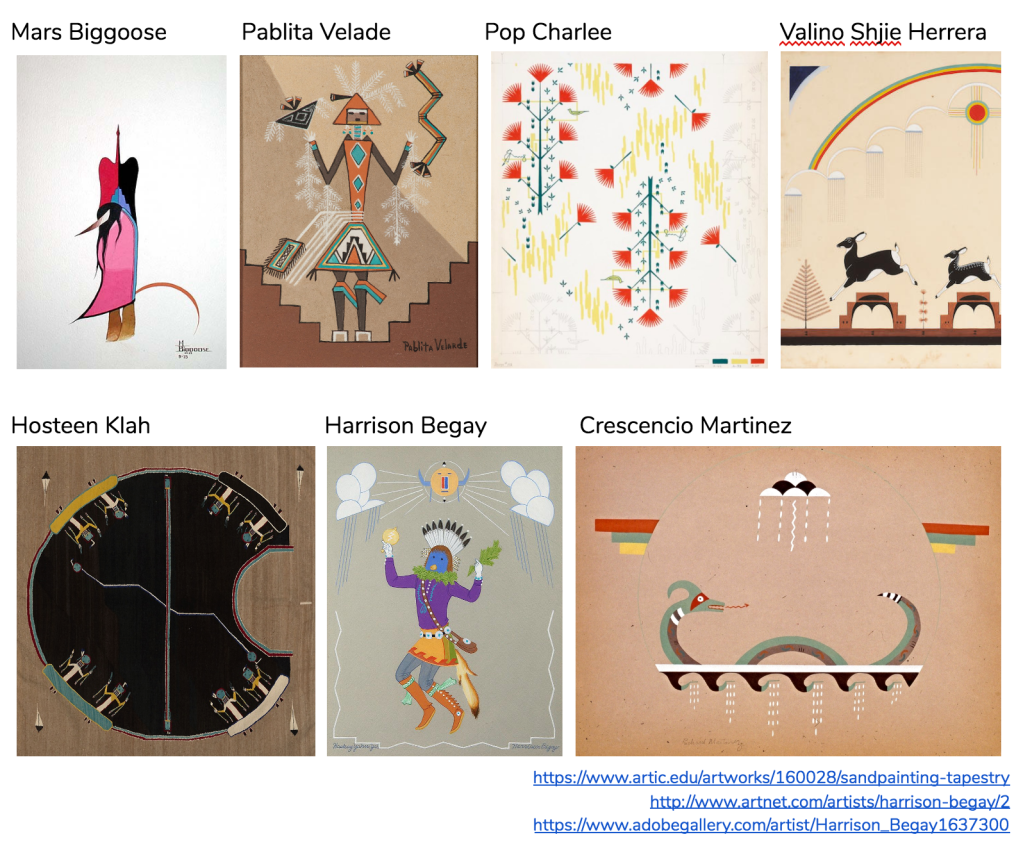
I instantly appreciated the artworks as aesthetically there are many similarities with some of the artists I am inspired by such as Lorena Lohr, Agnes Martin and Anni Albers.


I came across amazing carved dolls called Kachina, which embody spirits. These are ancient and contemporary and are representations of ceremonial dress.

On reflection I am excited by the serendipity of the project, a story about humanity’s loss of contact with nature, which I feel compelled to illustrate, has led me to discover artists that otherwise I would not have researched.
I have concentrated on developing characters and working through techniques and processes to inform an art style and visual language.

During the story of ‘Buffalo Gals won’t you come out tonight’ Myra sees her animal protectors in two different ways. With her human eye she sees them as animals, with her pitch eye she sees the animals as ‘her own people’, a humans. She is often in a state of confusion or falling, moving between the real and unreal. I think a solution to how she sees the animals during these transition stages would be for the characters to become their Kachina Doll versions. Kachina Dolls are small carved and decorated dolls made by Native Americans to represent mythological figures. The animals in the story are based on these mythological figures. Using the dolls as starting point, I have begun to illustrate and develop the animal characters.


Interview with Kit Gillson of Zone comics. Friday 29th March 2019. 4pm.
So, if I have read correctly, Zone came about after a comic book symposium held during the 2016 Guernsey Literary Festival. Can you reflect on what your initial thoughts about the project when you first came together as a collective?
Yes, the Guernsey Literary Festival in, yep 2016. As artists we were fed up with not getting anything done alone. THe symposium inspired us to think about doing things differently. Breaking into the UK for all of us as individuals seemed remote so as a group we figured that starting something on island [sic. Guernsey] would suit our energies better.
Now three years on, can you describe what has changed?
Yeah it has changed. We have lost some contributors but those of us that reman have got better at what we do. The first year we were unsure, the second year we were unsustainably over confident and ambitious with our expectations.
Is that why it took over a year to to get the third edition of Zone out?
Kind of. Through the process of making the third one we learned to keep our expectations in check and focus more on the outcome of the edition rather than having an overload of ideas.
At the start, would it be fair to say that as a group you didn’t really have a consistent message or concept for the publication?
All the contributors comics were very different and still are. That’s the beauty of it – variety. We are more used to working together now, that’s the real difference.
Does the variety in concept affect the audience you attract?
Yes and no. Anthologies are harder to sell but we throw a wider ner in that there is likely to be something for the casual reader.
What art styles would you say Zone has?
Well, from traditional European comic style such as bande dessinée to fairly experimental styles. The idea is there is no Zone style.
So the point is you don’t want a unified message?
We want stories, quality and variety.
As a collective are you a closed group?
Not entirely. We are open to committed contributors.
How actively do you search for new people?
Not very! We all keep an eye open but, we met organically so presume the mext will join organically.
Can you describe your group’s representation?
One hundred percent male, age range mid twenties to mid forties, all white. On contributor is from South Africa, one is Dutch. We all live in Guernsey.
How do you think your publication might change with a more diverse representation?
Our publication is not about politics. It’s about crazy stories. People who read our comic are not necessarily standard comic book readers so more variety would help this I guess.
What methods do you use to sell your comics?
Currently just at Zone events.
How do you see the comic moving forward?
With new contributors, we will become stronger as we refine our roles within the collective. We aim to make on going stories within the comics. Which will attract a readership base. People buy the comic for the variety and because it is local. But we hope they will come back for the next edition for the next installment of the stories.
Do you have high hopes for the continuing success of Zone?
We all have our individual hopes for what we are building. I hope the anthology will grow and we can build our own individual pathways from it. So launch our individual projects on.
Can you describe your role in the collective?
Co-founder or board-member, artist and writer.
How would you describe your art style, what does it bring to the collaboration?
I experiment with personal parameters, which are a consistent style throughout the story I tell in each issue, and then change the style in the next issue. I’m not sure if or what I will stick with as I’ve not been doing it all that long. I get bored if I don’t change things up. I definitely bring bold colour to the publication.
What are your main influences as a comic book artist?
Well, Guillermo del Toro and Mike Mignola, Hayao Miyazaki, Albert Uderzo and Didier Conrad of Asterix, and Jean-Pierre Jeunet to name a few.
Which contributors art style do you prefer and why?
I like the techniques of Fimbulwinter as it is made with traditional methods, full size, on paper with brush pen. But I also like Axolotl Had Face Man as it appeals to my sense of humour, the story and the art style.
You are also a film-maker, animator and TV camera operator. Do you think this has an affect on how you draw to tell stories?
I tend to think in camera angles. Some comic book artists use the page as a whole, or blend images together in interesting ways. But I think in camera angles. To say my comics are a storyboard would be underselling, but like a storyboard for a film I guess. Really its is about framing and composition of each panel like it is a different shot. I ask is the angle making the character humorous, or scary, assessing the relationship between the characters is important. So using film language really, in illustration.
How important do you think it is to be multifaceted as a practitioner? Does it help or hinder to be an illustrator and a film-maker, animator and TV camera operator? Would it be easier for you if you were defined by one discipline or specialism?
I find it doesn’t help me focus. I admire people who can do one thing. I try to keep the disciplines separate. There is some crossover as my creativity stretches over all the things I do. But I do think of them as separate. To be honest it’s something I’ve not really thought about. The difference between filmmaking and News camera, from the outside they might look the same, but they are very different.
Links:
https://www.kitgillson.com/ https://www.imdb.com/name/nm9153829/
https://www.linkedin.com/in/kit-gillson-948916a3/v
https://www.youtube.com/channel/UCjkCi-l5ZAv91p6ca7Q_FCQ
https://vimeo.com/323492767
https://vimeo.com/323504818
https://www.facebook.com/ZoneGSY/
‘Multiplicity’, a show organised and curated by Alice Nant and Ben Bailey-Davies, 29.03.2019 – 12.04.2019.

This is the GateHouse Gallery. It is a small three roomed space that was turned from a school tuck shop into a gallery five years ago. It normally shows work from local artists and raises money for the private school it is attached to. This is the first time the Further Education College I work at has had the opportunity to hold an exhibition here. The exhibition was designed to show development work of the students of courses from Level 1 to Level 5, without hierarchy, and promote the work we do at the College. In June the Course holds a end of year show for the Level 3 graduating students, since being in the art department (I joined in 2015) I have organised four shows outside the normal end of year event in order to showcase work from different student levels and celebrate all student achievement.

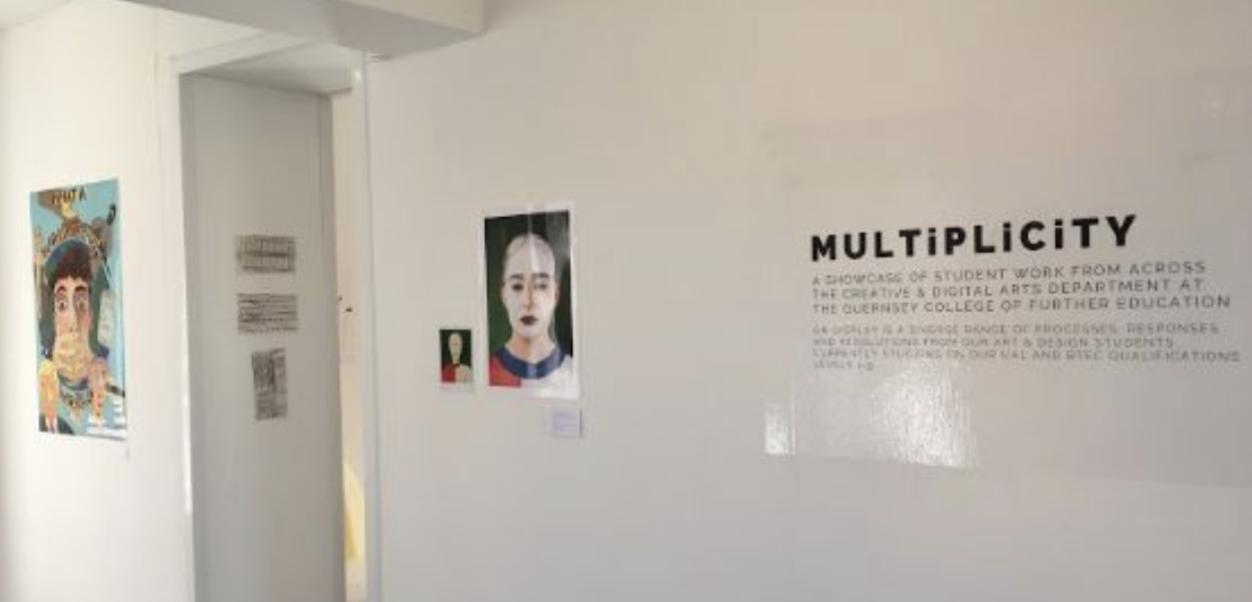
We chose a variety of student work from all levels including all types of art & design production including drawing, printmaking, textiles, video, animation, photography, graphic design, illustration, sculpture, prop making and sketchbook work.
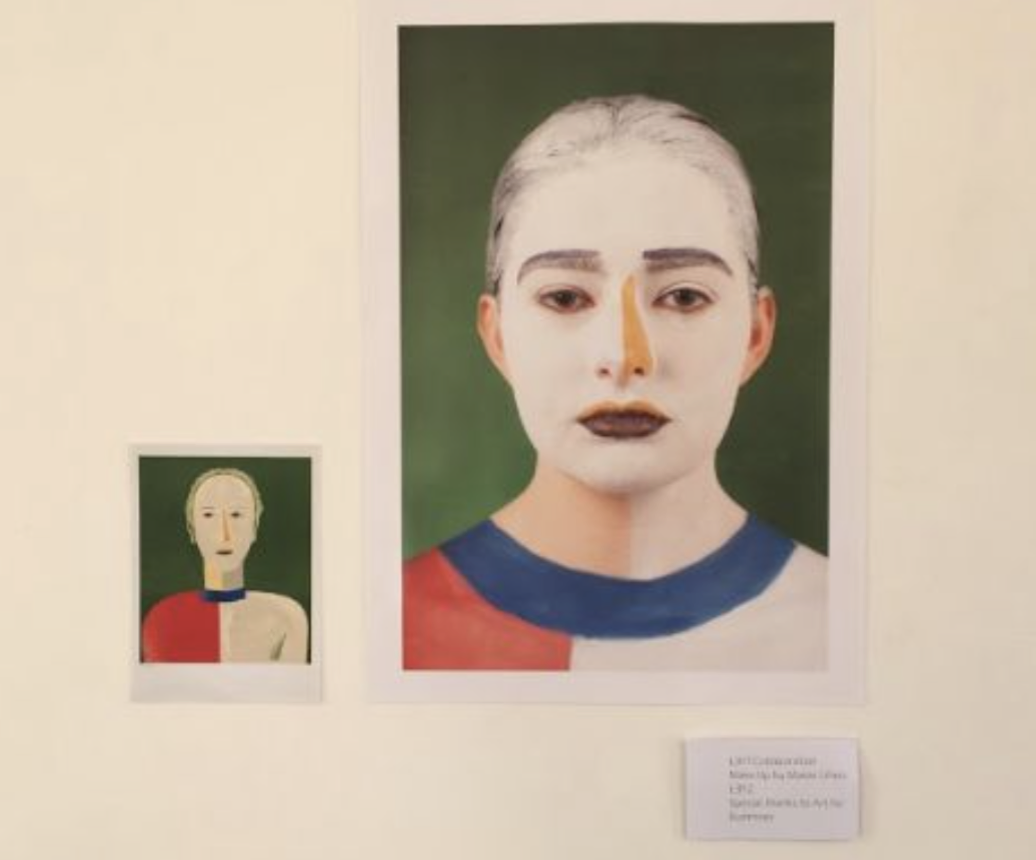
As it is a small gallery we tried to put in a wide variety of work trying to avoid making the space feel overcrowded.
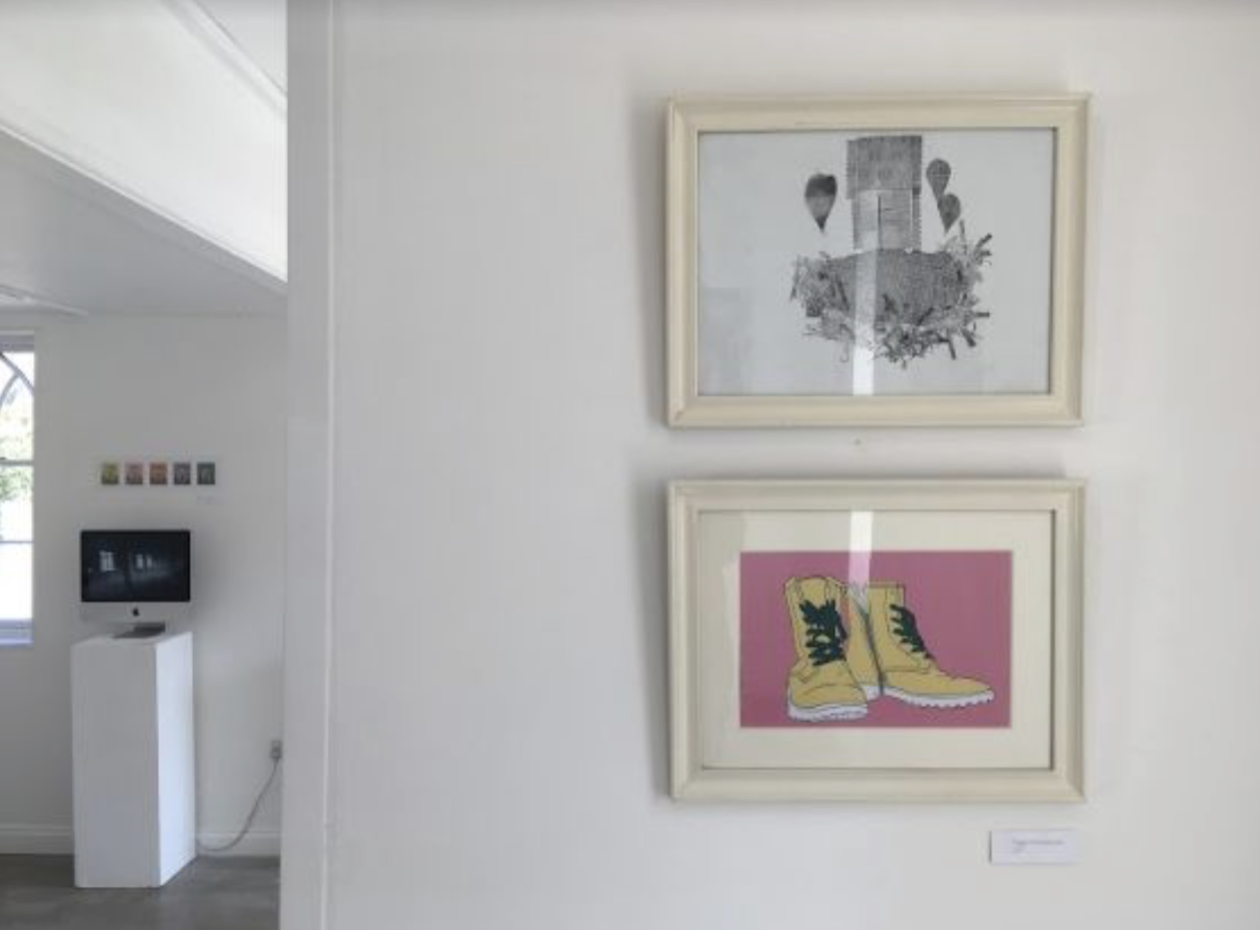

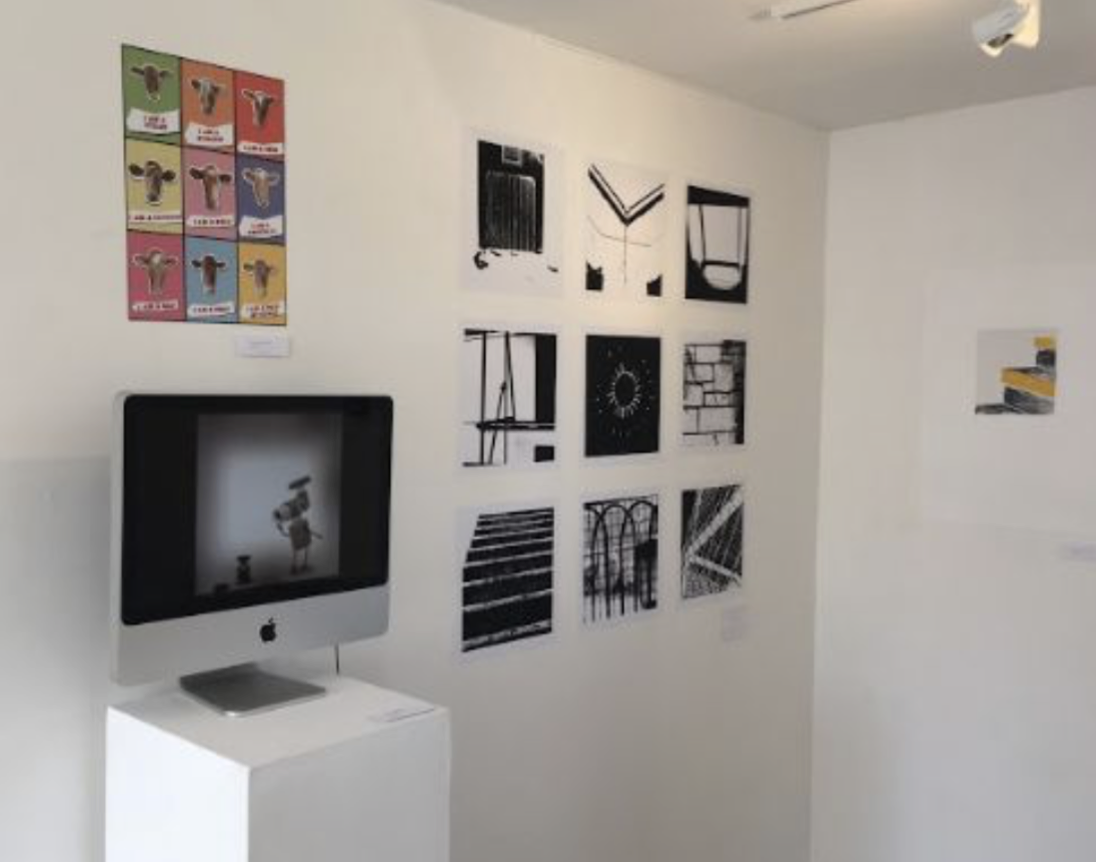
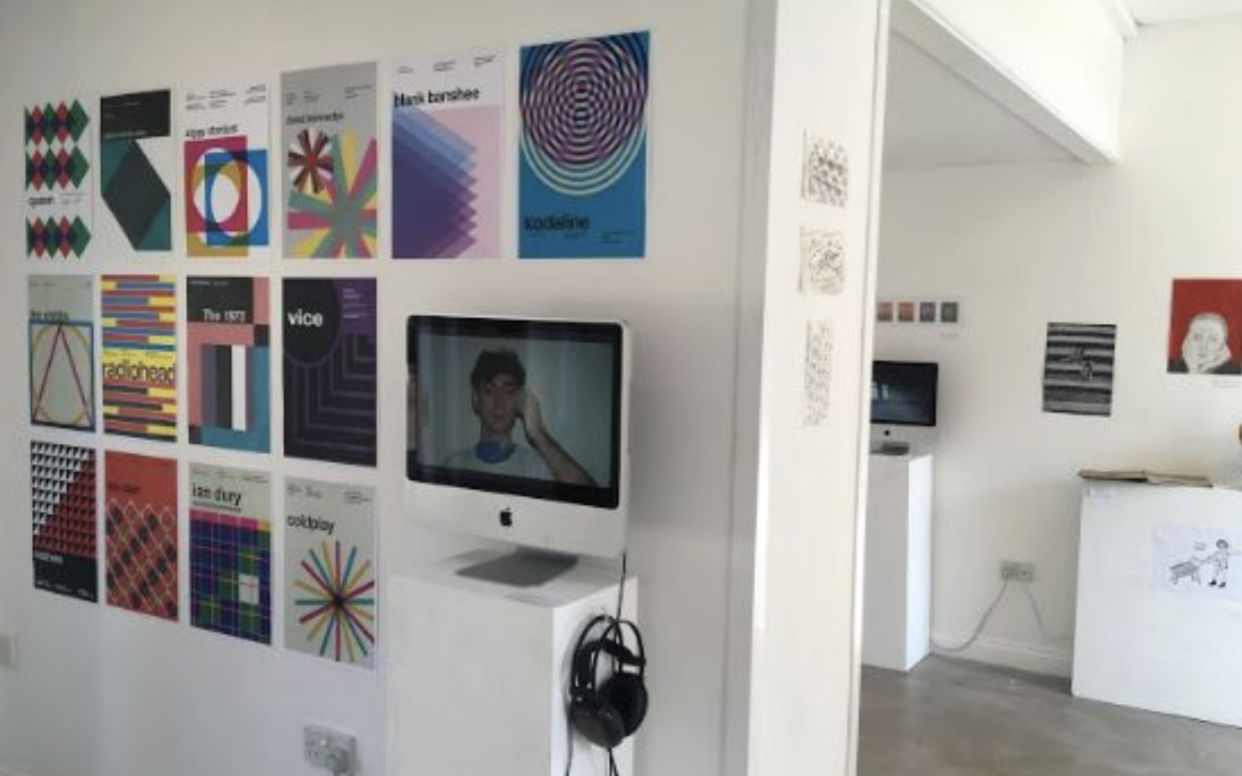
To order the space whilst maintaining a sense of space we hung the work in groups of grids and also tried to to visually join rooms as with the computers on plinths (above), and using images of faces (below). A continuity device to draw viewers through the separate spaces of the gallery.


We also employed window sills for small objects and used the natural light to highlight more delicate items.

There were a few interesting problems to solve. Including finding the best ways to display sketchbooks, a paper dress and a dress as a canvas for a video installation.


The projector for the dress video installation was put on a plinth in the centre of one of the rooms. Initially we thought this might be a problem, with technology blocking access to the work. But because the photography portraits at the back were visible through both the other rooms, the work drew the viewer’s gaze in and above the projector. Being bold with the projector placement worked successfully.
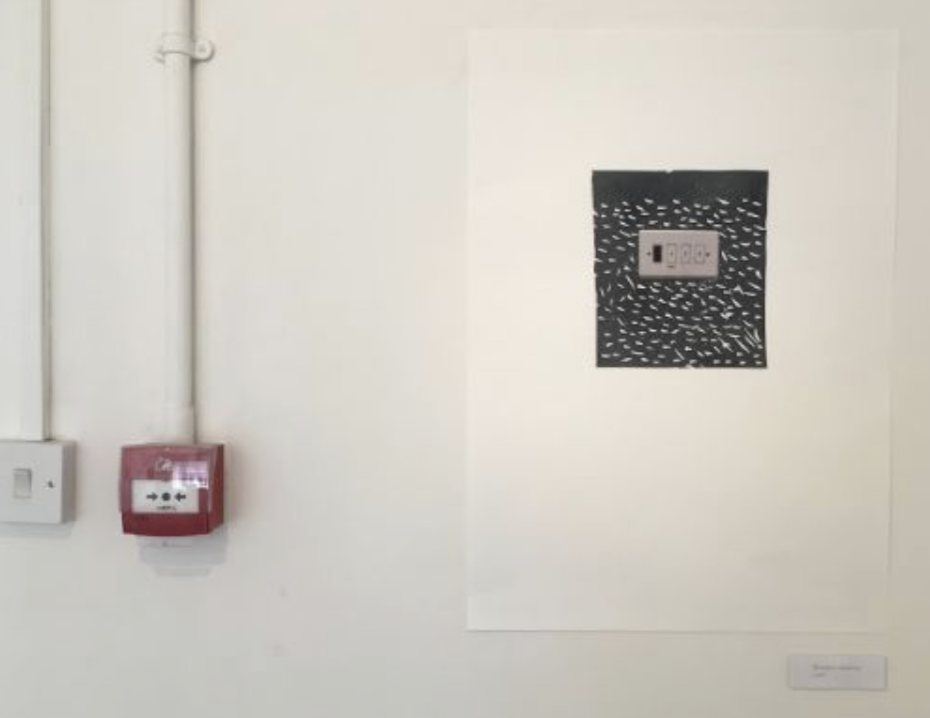
This awkward corner with a fire alarm and light switch was complemented by a block print of a switch plate.
There was an opening evening with a good turnout, media coverage with good reviews and the show was up for two weeks. The success can be measured with College management agreeing to this showcase becoming an annual event.
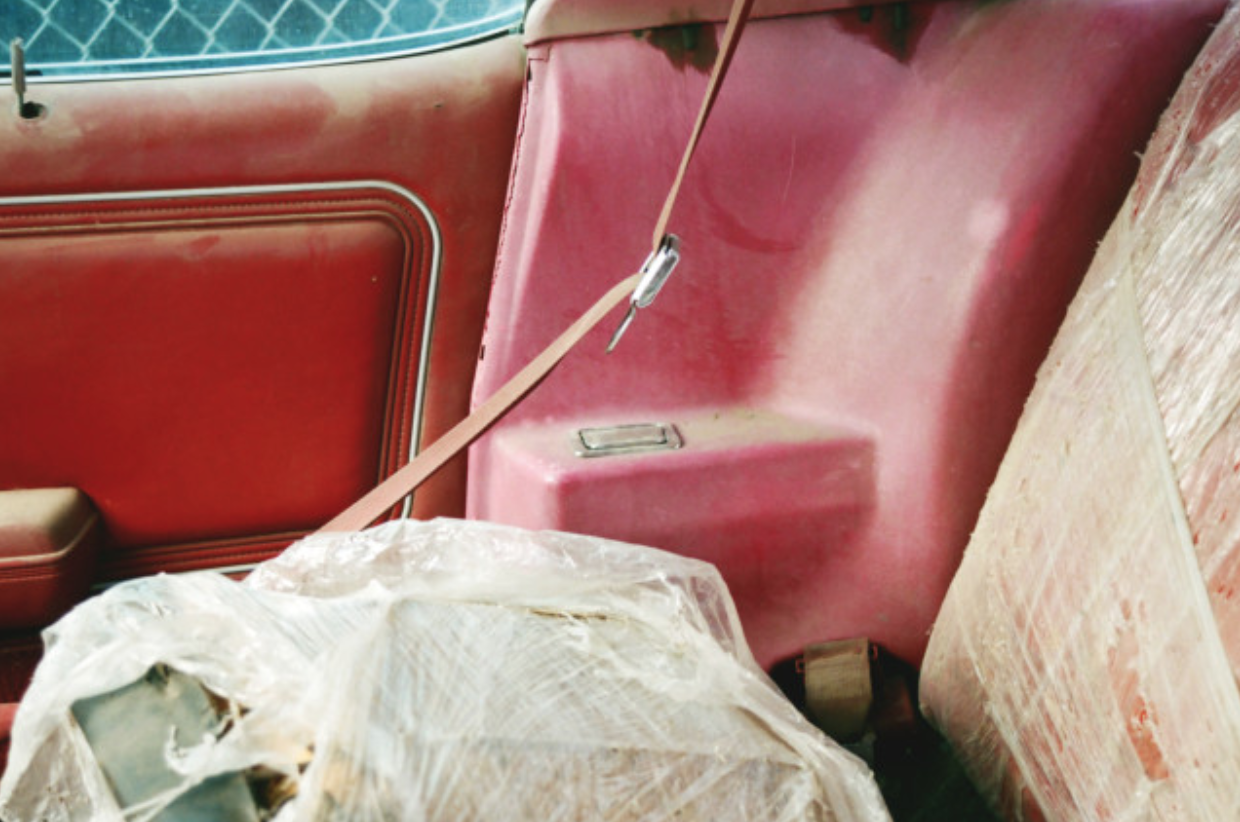
Lorena Lohr, Untitled, 2017

Hieronymus Bosch, Garden of Earthly Delights, c.1500
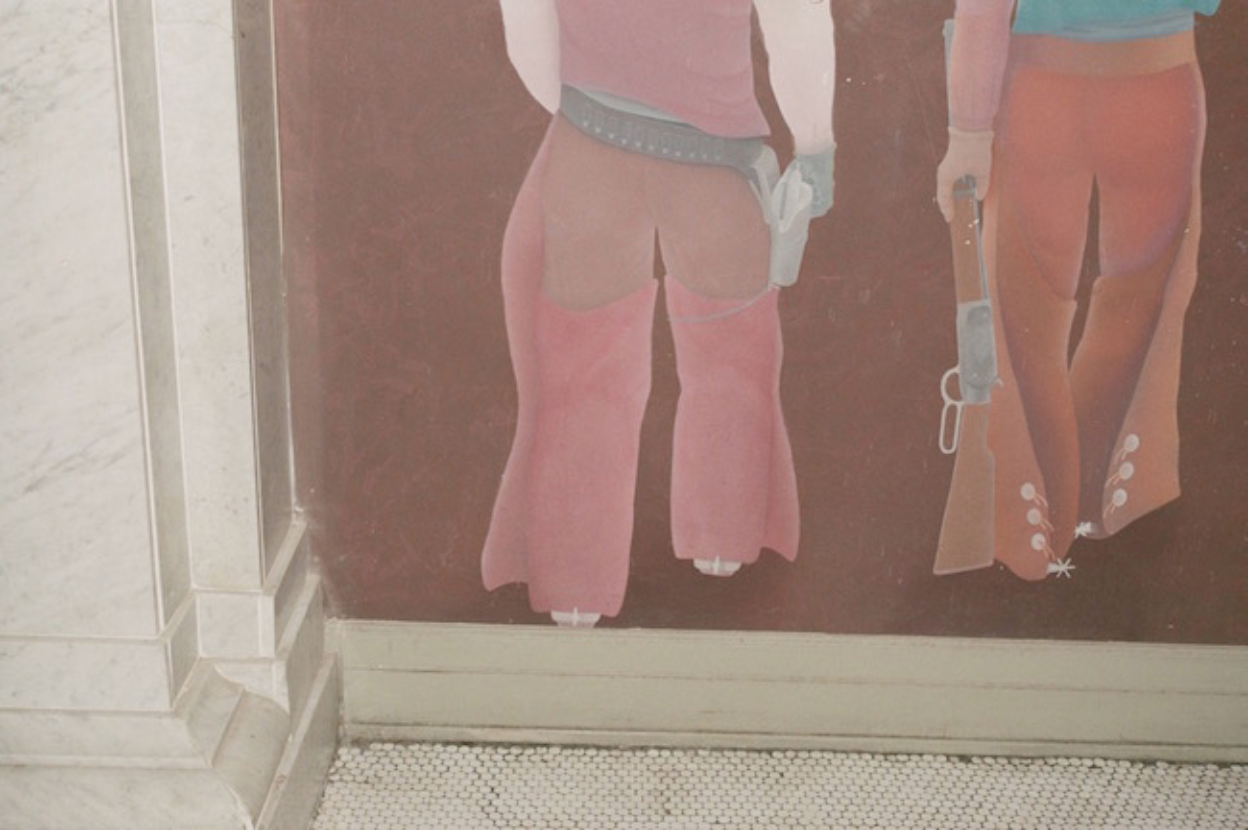
Lorena Lohr, Untitled, 2017
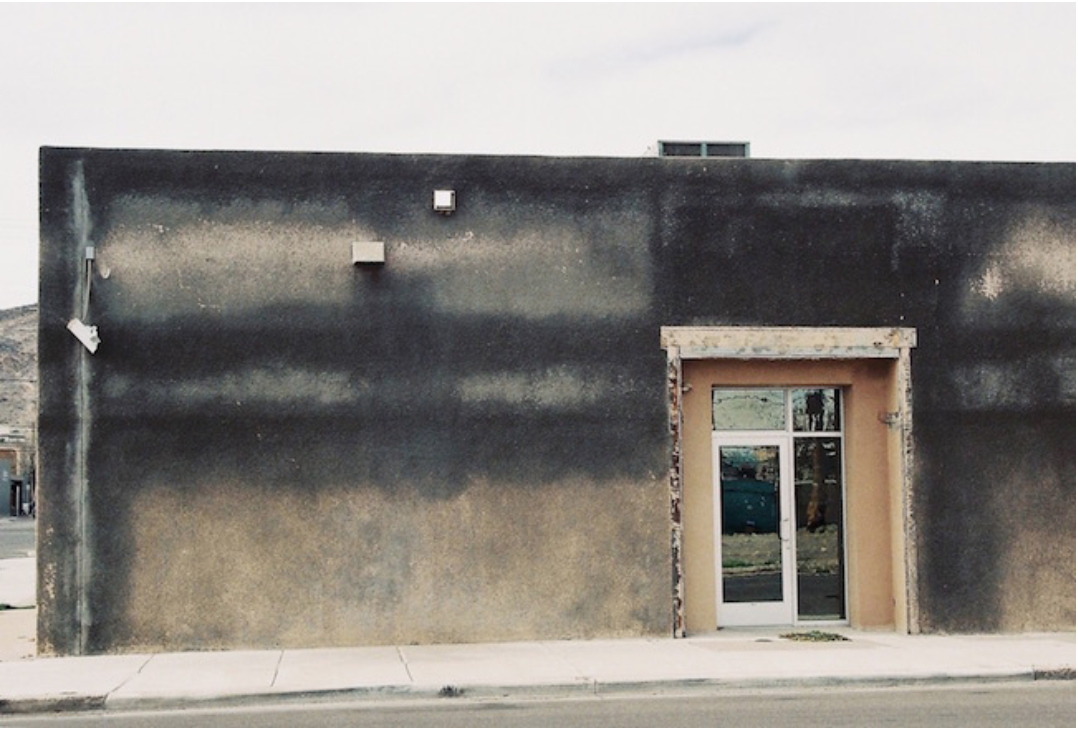
Lorena Lohr, Untitled, 2017
Sources:
Collectionair, Ones to Watch, One-On-One: William Eggleston And Lorena Lohr, 2016 journal.collectionair.com/ones-to-watch/one-one-william-eggleston-lorena-lohr/
Wise, L, From Gucci ads to Instagram fads: how the Wes Anderson aesthetic took over the world, April 2018 www.theguardian.com/film/2018/apr/07/from-gucci-ads-to-instagram-fads-how-the-wes-anderson-aesthetic-took-over-the-world
Benson, L, Lorena Lohr Exhibition Introduction, Claire de Rouen Books, 2016 clairederouenbooks.com/collections/photography
Hernandez, C, An Interview with Lorena Lohr on Traveling To Where No One Goes, Lomography Magazine, 2017 www.lomography.com/magazine/333230-an-interview-with-lorena-lohr-on-traveling-to-where-no-one-goes
When I began this journey I wanted to subvert existing forms of visual language, disrupting production based connotations and assumptions. I began to realise that what I was looking for came from need for my visual language to be heard in a suitable framework, in an appropriate space. I have worked in film, fine art and textiles which all come with their own inherent language which is taken into consideration when making and viewing the work. In film I make feminist movies, in painting I make female art and in textiles I use traditionally female techniques to make a point. I do none of these things, but also, I do because I am using media and techniques with a prescribed language. I want to work in a way where my work is work.
Whilst undertaking theoretical research and making practical work I came to the realisation that looking backwards and being frustrated was hindering, and blocking, my creative development. I began to discover practitioners that operate in a fairly ‘new’ environment and are investigating it for its potential and it’s visual language. For instance practitioners like Jenova Chen that strive to use video games for artistic and illustrative purposes, and others that seek to claim a digital space for new creativity, such as Harvey and Samyn and their Realtime Manifesto. I too want to explore this potential and discover and define the visual language.
Therefore, through the process of beginning my MA journey I have discovered that that to look forward, and investigate the new, might allow me to find a way to make work in a language or framework that feels appropriate.
I have enjoyed undertaking initial research and reading about Carl Einstein’s tectonic understanding of Hegel’s dialectics. I can see value in investigating theorists such as Leif Weatherby and his proposal that ternary computing has the capacity to provide a metaphysical space. These investigations will help me frame my understanding of the metaphysical space of the digital and allow me to begin to define a space within this for my work.
Overall I have felt able to write a proposal for the next phase of my MA and can begin to see a way forward to a final outcome. I found writing a proposal at the start of the process almost impossible. I felt I knew what I wanted to set out but it lacked clarity and depth. I now feel able to write a proposal with some clarity and I am confident that the depth and understanding will come with further research.
For instance I am certain of the direction of my practical work for the start of the next phase and know that will lead to further theoretical research and analysis. I also know my theoretical research interests and I am excited to discover how these will affect my practice. I know too, that experimenting with and learning new technologies will enable further progress and I am looking forward to the clarity of work to come.
I have been investigating redundant technologies. In particular drawing interfaces with 8 bit computers. In particular the Commodore 64.
There are two reasons for choosing the C64. The first is that I managed to acquire two working consoles, and the second is that it was the first computer I experienced.
I have discovered that there were a number of interesting interfaces that could be used to draw with a C64.
The Koalapad.
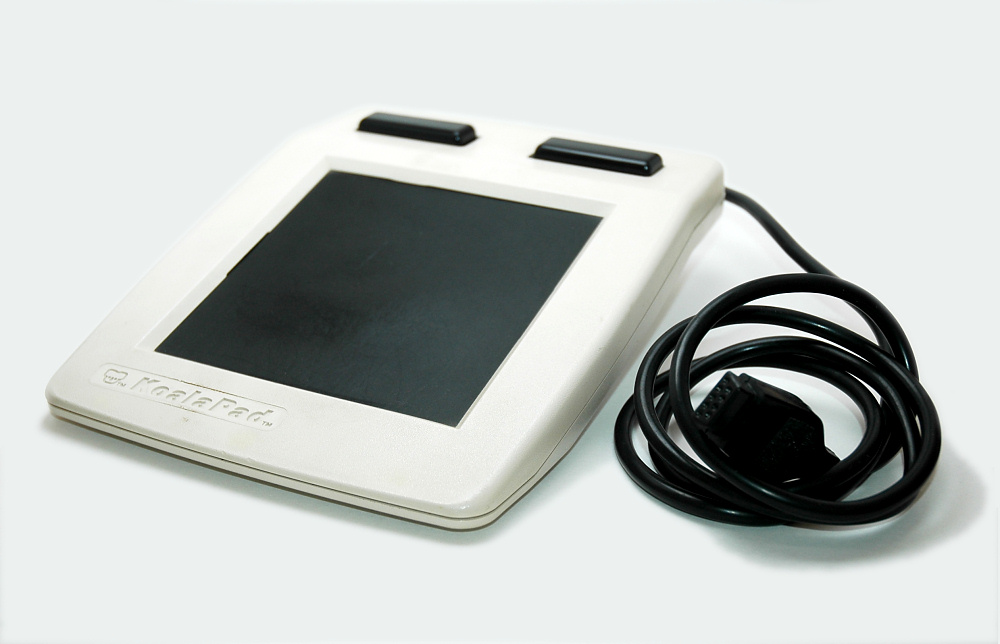
Before Wacom, the Koalapad was an interface that could be used as a grahpics tablet even though it was designed to be used for accountants and data input. Occasionally there have been Koalapads for sale on Ebay, however, they seem to be sort after and rare as they are reasonably expensive.
The CAD-MASTER LIGHT PEN.

The Cad-master Light Pen is an interface that connects through the controller port of the C64. The pen is then used directly on the monitor screen, which needs to be a tube screen. It works by transmitting and receiving light in the same way the zapper gun did in the Commodore 64 game Duck Hunt. I have bought a Cad-master Light Pen and a copy of the software ready to use with my C64 and an old JVC TV.
Images from artist’s website: jenovachen.info
The art-videogame ‘Journey’ is a stunning, illustrative experience and whilst visiting ‘Videogames: Deign/Play/Disrupt’ at the V&A I learned about the production and art of the game.
Jenova Chen is the art director and concept artist of the indie videogames company ‘thatgamecompany’. He, and his company, are award winning practitioners that have produced the art-games Flow, Flower and Journey. he is also the co-founder of Anapura Ineractive which encourages and support emerging creatives.
Chen describes game content as “The soul of a video game”, and has produced research papers on the concept of ‘Flow’ in games.
A concept that I admire with the game Journey is that it is a multi-player game which allows you to interact with other players over the Internet. However, players cannot talk to each other or touch. They can interact through movement and sound. Creating an uplifting interaction.
There is a philosophy behind his work, he states “I started to realize there is an emotion missing in the modern society, and of course missing in the online console games. It is the feeling of not knowing, a sense of wonder, a sense of awe, at the fact that you don’t understand, at the fact that you are so small and you are not empowered”.(1) Therefore he aims to create games as a space, or an environment, for spirituality and connection. He has said that audiences for film can find romance, sensuality, spirituality and humanity, however in videogames it is difficult to find anything other than violence and the need to win at all costs. I not only appreciate his art style, but also his philosophy.
References:

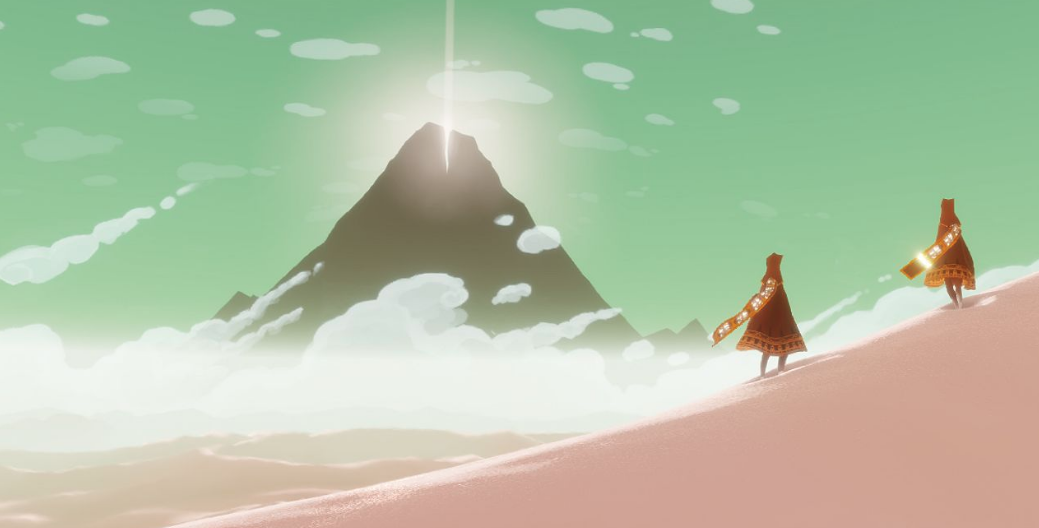


A annotated bibliography of a number of interesting and useful texts.
1. Bergo, C,. (2014). The Poetics of Female Death: the fetishization and reclaiming of the female corpse in Modern and Contemporary Art. Graduate. University of New South Wales.
| This paper references Bataille and Krauss and addresses voyeurism and the fetishisation of female death. The paper outlines how historical and contemporary images by men of female death are erotic due to the passivity of the corpse. Whereas, although depictions of male death by male artists can be given meanings such as heroism, they are not erotic. The paper states that female images of female death cannot be voyeuristic spectacles because the depicted figures are beings and not objects. Therefore the image of female death, for female artists, can be a voice for a female discourse on the female body. |
2. Brusentsov, N; Ramil Alvarez, J. (2011). Ternary Computers: The Setun and the Setun 70’, [downloadable PDF] Available Via HAL archives-ouvertes.fr. https://hal.inria.fr/hal-01568401 Petrozavodsk, Russia.
| This is a short and focussed conference paper delivered at Moscow State University in 2011. An interesting paper and relevant to my research in that it enables an entry point to understanding ternary computing. The paper explains to an extent “the dialogue system of structured programming” with trits and trytes, instead of bits and bytes, and -1, 0, +1 instead of binary 01 language. The paper is in five parts and addresses in turn the idea of ternary computing, the economics of Setun’s internal architecture, symmetry in ternary mathematics, the development of the Setun 70 and the Setun 70 & automatism. |
3. Dill, K.E; Thill, K.P., (2007) Video Game Characters and the Socialization of Gender Roles: Young People’s Perceptions Mirror Sexist Media Depictions, Berlin: Springer Science & Business Media.
| A presentation of data from two studies designed by the authors. They wished to prove that video game stereotypes detrimentally affect the gender perceptions of young people. In Study 1 video game magazines were analysed and determined that 82.6% of male images were aggressive and a third of these were hyper-masculine. Females were under-represented in the top selling magazines and were sexually objectified. Study 2 questioned teenagers about game characters and showed overwhelmingly that male characters are aggressive and female characters are sexualised, concluding that extreme stereotyping is employed in video games, males as aggressors and females as objects. |
4. Günther, G., ‘Cybernetics and the Transition from Classical to Trans-Classical Logic’, BCL Report 3, November 1965, Biological Computer Laboratory, University of Illinois.
| I was drawn to this article as it contains various mathematical diagrams that I connected visually with (post)structuralist diagrams, such as those used by Krauss to describe expansion. I am interested in investigating this connection to discover if this is my interpretation or if there exists a valid academic precedent. I found this article difficult with its authoritative scientific manner. However, it does describe the differences between classical logic (binary) and trans-classical logic (non-binary) in a scientific and non philosophical way. This has facilitated the understanding of this branch of logic as it is clear and clinical in description. |
5. Harvey, A; Amyn, M,. (2018). ‘The Realtime Art Manifesto 12 Years Later’ in Foulston, M, Volsing K,. (2018). Videogames: Design / Play / Disrupt. London: V&A Publications, pp. 90 – 97.
| ‘The Realtime Art Manifesto 12 Years Later’ is the seventh chapter of the book ‘Videogames: Design / Play / Disrupt’ which accompanies the exhibition at the V&A. I am interested in the text as part of my search for spaces or platforms for unheard voices. Harvey and Samyn are collaborative artists making art-videogames. They launched their Realtime Manifesto in 2006 at the Athens Mediaterra Festival of Art and Technology. The text concerns the review of their manifesto which set out an optimistic creative usage of digital space. This paper ends negatively describing their disillusionment of the reemergence of corporate broadcast models. |
6. Joyce, C., (2003). Carl Einstein in documents and his collaboration with Georges Bataille. Philadelphia: Xlibris.
| Carl Einstein (1885-1940) was an anarchic art historian who has become prominent since the journal ‘Documents’ (1929-1930) became of concern to academics such as Dawn Ades and Rosalind Krauss who were interested in Documents and Einstein’s working relationship with Georges Bataille and their influence on Surrealism. Further interest in Einstein focussed on enabling the understanding of Formalism as a revolt. I admire Einstein’s quiet rebellion against the art, culture and politics of interwar central Europe. This book compares the intellectual rebellion of Einstein with the ‘unknowledge’ of Bataille. Joyce does this with diagrams and linguistics which I find particularly interesting. |
7. Kallman, H.J., (1986) A Commodore 64-based experimental psychology laboratory. Albany: State University of New York.
| An interesting example of how the C64, BASIC programming and simple HAL Lab games began to significantly change the way research was undertaken in the field of psychology. It is an experimental scientific report showing technology was as interesting in scientific arenas as it was in creative ones. It describes cross over between fields, with music programmes used to gather data along with using the first graphics tablet, a Koala graphics pad, to record responses to visual stimuli. The limitations of the C64 are discussed against advantages such as the increased productivity when interfaces, such as the Koala, were employed. |
8. Lakoff, R., ‘Language and a woman’s place’, Language in Society, Vol.2, No.1, Apr 1973, pp. 45-80.
| This 45 year old text has relevance although somewhat self-reflective with personal opinion. The author does clarify this at the outset, she explains that because of a lack of scholarly evidence and research she needed to use her personal reflections. Lakoff sets out how our use of language implies women are less significant than men. Fundamentally because our language has different engendered words for the same thing, example bachelor (free with choices) and spinster (alone, unchosen) there is a culturally understood difference between male and female. Lakoff calls for further research into the cultural effect of language on gender roles. |
9. Noyes Vanderpoel, E., (2018). Color Problems, A Practical Manual for the Lay Student of Color. New York: The Circadian Press with Sacred Bones Books.
| Emily Noyes Vanderpoel (1842-1939) is a largely overlooked artist and writer. Her first book (1901) contained beautiful diagrams to describe the science of colour theory and charted objects she deconstructed using colour analysis. She deployed ‘the Grid’ long before it became a stage for formalism. The extent of her influence on early modernist aesthetics is unknown and the reprinting of her first book is an attempt to instate Vanderpoel as a visionary who influenced minimalism and formalism. I am interested in her forgotten voice and her early use of the grid as a method of studying colour as visual language. |
10. Rumold, Rainer. (2004). ‘Painting as a Language. Why Not? Carl Einstein in Documents’. October 107, 2004, pp. 75-94.
| This paper was published in ‘October’ and as such is authoritative and uses dense, obtuse language, but also it is well researched and reliable as commentary on Carl Einstein. The document outlines what Rumold surmises is Einstein’s paradoxical experience of early modernism (1920s) being a critic of the avant-garde whilst fundamentally involved in the avant-garde. He suggests that Einstein was dissatisfied with modernism’s structuralist position within the unconscious and a critic of modernist subjugation of the unconscious through structural linguistics. The paper characterises Einstein as Postmodern (in 1929) because of his moves to overthrow the elite by being consciously underdeveloped. |
11. Weatherby, L., ‘Hegel 2.0 – The imaginary history of ternary computing’, Cabinet Issue 65 Knowledge, Winter 2018, pp. 33-42
| In this scholarly yet accessible article Weatherby positions American Cybernetics against Soviet. Although pioneers in both countries were working towards ternary computing, their philosophies were at odds. The soviet programme existed during Kruschev’s thaw where efficiency was key, the American concerned with more metaphysical outcomes. The article is divided into two parts. The first considers binary oppositions and the second trans-classical logic. The paper addresses how we might understand computing in dialectical Hegelian terms or how we might understand a digital space where the real and the imaginary combine. It suggests that a metaphysical non-binary digital space warrants further research. |
12. Zinman, G., (2016), ‘The Archival Silences of Nam June Paik’s Etude’, Computing Frontiers, Orphans X Film Symposium 2016, Georgia Tech.
| In this text Zinman presents an ‘unknown’ work by Nam June Paik which he himself discovered in the archives of the Smithsonian called ‘Etude’ made in 1967. Zinman suggests that this particular work is key in rethinking our relationship with the digital and our digital past. Etude was discovered outside of its original context and seen for the first time fifty years after it was made. Paik is no longer alive to explain the work, therefore it is down to critics and audiences today to infer the works’ meaning within our current digital context, a digital context distinct from 1967. |
Critical Analysis of Weatherby, L., ‘Hegel 2.0 – The imaginary history of ternary computing’, Cabinet Issue 65 Knowledge, Winter 2018, pp. 33-42
‘Hegel 2.0 – The imaginary history of ternary computing’ is a short article written by Leif Weatherby, who writes about digital theory and idealism. A reason for choosing this text is because the article was published in this quarters edition of ‘Cabinet’ and is therefore very current. The article is divided into two parts and I have chose to address the first. The text ends with a discussion about trans-classical logic. However the first section I find more interesting because of the discussion about binary oppositions in computing. Weatherby suggests that a ternary computing, rather than the binary computing we use, has the capacity to provide a meta-physical space. Through a clear and logical text Weatherby locates American Cybernetics in the 1950’s and 60’s in opposition to their Soviet counterparts. He describes how both sides were building the first ternary computers, although for seemingly very different reasons. The soviet programme was motivated by efficiency reflecting the political climate of the era under Kruschev. American concerns, states Weatherby, were more metaphysical. He goes on to relate the short history of ternary computing, whereby binary computing being easier and cheaper to produce, investment was removed from the ternary projects in America. Similarly in Russia, Kruschev introduced the German IBM computing standards, which stopped any further research into ternary computing.
When discussing metaphysics and ternary computing Weatherby applies Hegelian terms of dialectical thought to describe a digital space where the real and the imaginary combine. For instance he describes ternary computing in the following terms: Binary = 1 and 0, Ternary = 1, 0, -1 or thesis, antithesis, synthesis. With this he intimates the space for the thinking computer, or the ability for the computer to negate or contradict its own logic, in other words, artificial intelligence.
This does sound rather far-fetched, and although written elegantly, the Hegelian application does seem a little engineered. All arguments put forward are referenced and supported by research which validates the text as philosophical reasoning rather than in any practical or technical application.
The construction of ternary logic mechanisms that Weatherby set out in his paper interest me not because of the potential discussions of the viability of artificial intelligence, moreover my interest is in the possibility provided by thinking of computing in ternary terms. It intrigues me because of the notion that within a logic system there is the possibility of slippage. By slippage I mean in the way Bois and Krauss use slippage in texts like L’informe mode d’Emploi. They praise Georges Bataille as a major proponent of slippage. What is interesting here is Bataille fought against Hegel preferring a non-dialectical conceptual approach.
“For Bataille, there is no third term, but rather an ‘alternating rhythm’ of homology and heterology, of appropriation and excretion. Each time that the homogeneous raises its head and reconstitutes itself (which it never stops doing since society coheres only by means of its cement, the job if the informe, base materialism, and scission is to decapitate it. What is at stake is the very possibility of a non dialectical materialism: matter is heterogenous; it is what cannot be tamed by any concept.”(1)
Although is more contemporary writing Krauss is contradictory as she uses the idea of slippage in a psychoanalytical appraisal of modernism, demonstrating a continual antithesis and synthesis of an established logic, or the thesis of modernism.
Slippage (or the informe) though seems too fluid in the case of ternary computing as Weatherby seems to intimate. The movement implied by ternary computing opens the possibility of space, creative space, but in not a freefall or in chaos. So, if not slippage, then perhaps the tectonic is more appropriate. Carl Einstein’s theory of the tectonic was a more grounded version of formlessness, or slippage. For instance, rather than a primitive and base unconscious, Einstein’s was a theory that existed in the consciously underdeveloped. A rather more grounded and positive outlook on the formless.
Linking Hegel to Einstein through ternary computing is not implausible. Einstein used Hegel to analyse Picasso, and ideas of dialectical logic to analyse Klee. Einstein’s tectonic can be described as mapping reason onto the real, the real being the unreasonable, which makes the real a fiction.
“Every reality is merely a section that is continually replaced and displaced. Hence there is a constant and simultaneous construction of counter-realities, so that the real needs to be understood as a pluralistic complex. In actual fact, beyond a reality that has been fixed there exists a sphere of permanent creation and metamorphosis, that is, of the continuous revolt against the imposed world picture.”(2)
Weatherby calls for more research into the metaphysical possibilities of ternary computing and is clear that he is proposing an idea, and not stating a coherent theory.
One thing that needs to be clarified through further research is the understanding of ternary computing terms of 1, 0, -1. According to Connelly, “Ternary computing deals with three discrete states, but the ternary digits themselves can be defined in different ways”.(3) These are 1,0,-1 known as ‘balanced trinary’, 0,1,2 ‘unbalanced trinary, 0, ½, 1 ‘fractional unbalanced trinary, F?T unknown-state logic and T, F, T trinary coded binary. This opens up possibilities, firstly understanding what these mean, and how they affect Weatherby’s proposal that ternary computing has the capacity to provide a metaphysical space.
In summary, this article is both intriguing and frustrating. It is written by an established academic who writes with conviction in a readable and well reasoned way. But also it does not provide the answers to the questions it poses through the proposal that ternary computing offers a space for creativity and philosophy.
References:
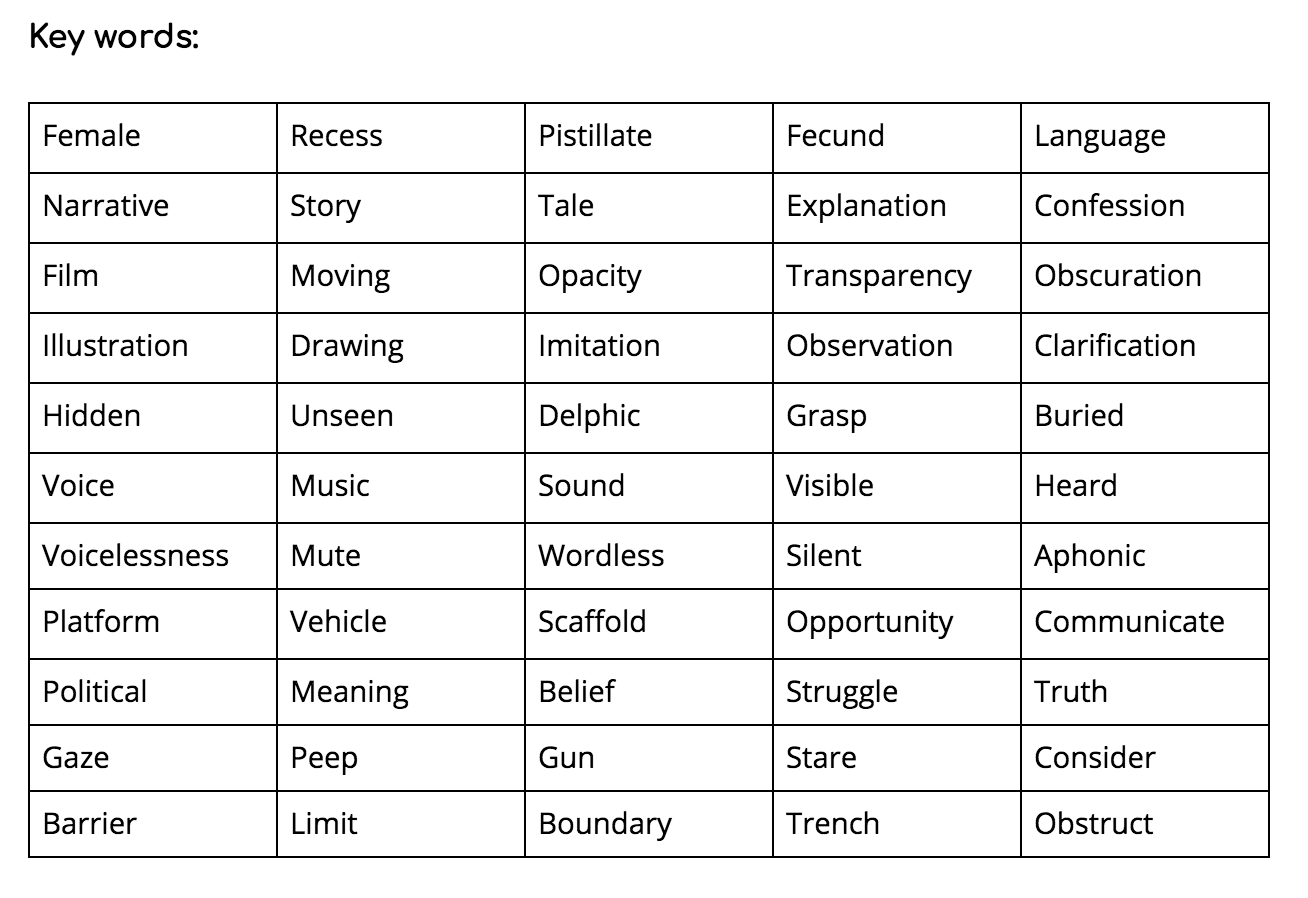

Research Boundaries
| Things I already know: I know about semiotics and structuralism, I know about modernism and the how it does not fit its categorization, I know about the language of film, I know about different visual storytelling methods. I know about feminist cultural critique. I know 20th century art and design. I have a grasp of current politics. I have a grasp of old and redundant image making technology. |
| What interests me about this topic: Can video be defined as a language or distinct system of communication? Is it more than a digital format? (Painting has a language, film has a language, video is empty). Can the female voice thrive within the language of video? Is video where voicelessness exists? |
Possible Sources:
Bergo, C,. (2014). The Poetics of Female Death: the fetishization and reclaiming of the female corpse in Modern and Contemporary Art. Graduate. University of New South Wales.
Dill, K.E, Thill, K.P., (2007) Video Game Characters and the Socialization of Gender Roles: Young People’s Perceptions Mirror Sexist Media Depictions, Berlin: Springer Science & Business Media.
Kim, H., ‘Indeterminate Temporality Embedded in Nam June Paik’s Early Experiments from 1959 to 1963’, Journal of TFAM No.34, 2018, pp. 9-20.
Lakoff, R., ‘Language and a woman’s place’, Language in Society, Vol.2, No.1, Apr 1973, pp. 45-80.
Zinman, G., ‘Nam June Paik’s Etude 1 and the Indeterminate origins of Digital Media Art’, October 164, Spring 2018, pp. 3-28.
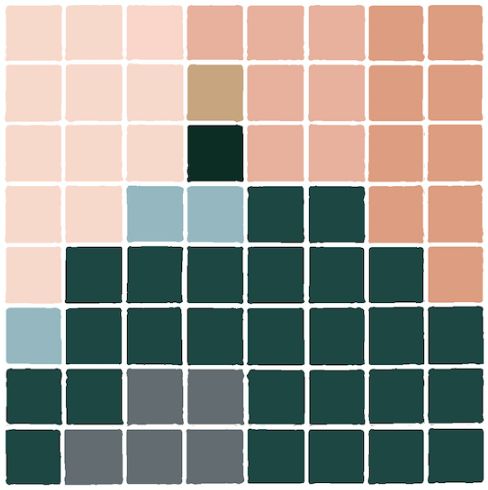
I have enjoyed discovering my research methodology identity. At first I enjoyed learning about research methodologies and understanding in more detail the concepts of practice based research. This perspective revealed a deeper understanding of my own relationship with research and practice. I also enjoyed organising and mapping my initial research interests, I enjoyed the challenge of taking a pragmatic brief to transform the collected data into interesting visual communication.
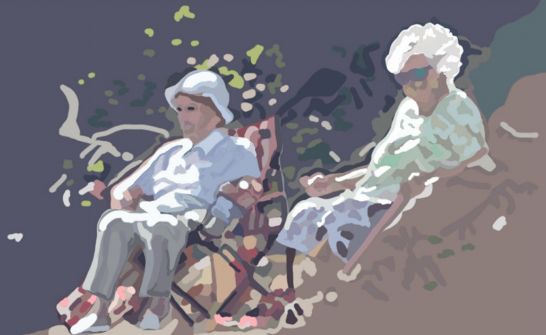
I do not believe I have found any of the programme ‘easy’ but I would said the ‘easiest’ section has been Practice Part One where I was drawing, illustrating, collecting, thinking. Being with old friends, the familiarity of process. It was enjoyable too.
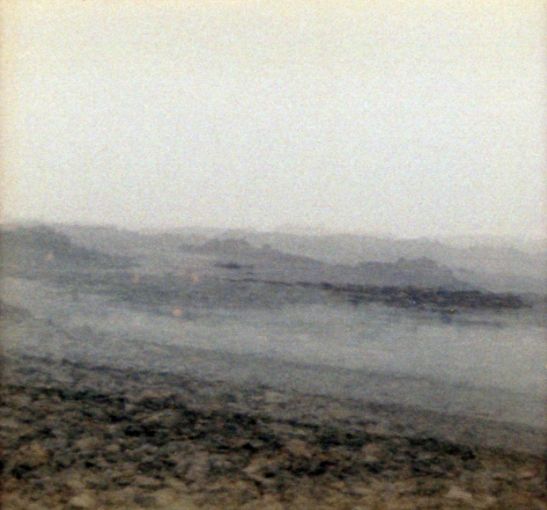
I find it difficult to write project proposals and be self reflexive in an objective way when considering what it is I want to do within a time frame. Understanding my methodology has helped with this. I am led by discovery. I discover through making and learning, practice and research working together to create new avenues. This is why I find it difficult to pin down exactly what I want to do, as I don’t know what it is ‘exactly’ until I’m doing it.

Confusion is time consuming. I find writing down each learning task by hand in a notebook, rereading the notes and cross referencing with the website is the only way I can be confident I am working through the material accurately. And even then I am often caught out by my unreliable memory, like pebbles on the shore, it shifts and changes and order becomes chaos.
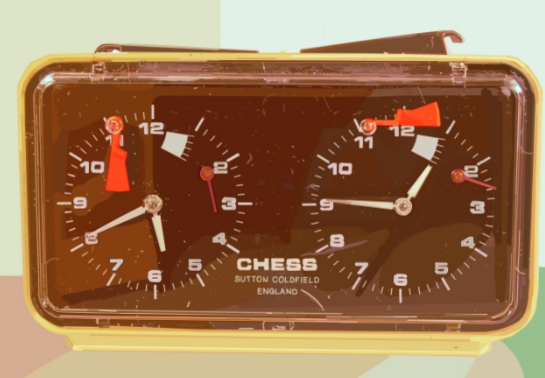
One thing I was very conscious of and concerned about when deciding to commit to this programme was devising and keeping to a routine. This routine is regular and therefore a strength. I have carved a time and space for creativity. I have found more and more I can efficiently switch from from life brain to creative brain. This is invaluable and the rest of my creative processes are built on this.
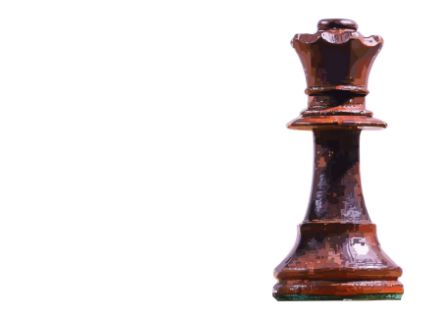
Being able to analyse what I do by understanding my methodologies has been invaluable and easily the most important thing I have learned so far. I feel stronger and more confident as a researcher and practitioner. Learning about my practice allows me to identify areas that I want to explore and why I want to explore them. Learning about the redeployment of redundant technologies has been compelling, stretching and challenging and is definitely a specific area I am exploring further.

Focussing my thinking around my place in a/the creative arena during the planned walk and subsequent pecha kucha presentation in the Creative Industries: Local Perspectives module has been inspiring. The activity allowed me to consider the space I occupy as a practitioner and to identify where my voice is, and where it should be.
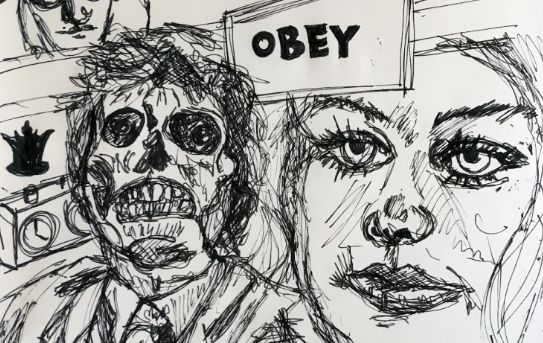
I absolutely understand the importance of citing sources accurately and fairly but I need to improve my organisation, ability with and understanding of Harvard referencing.
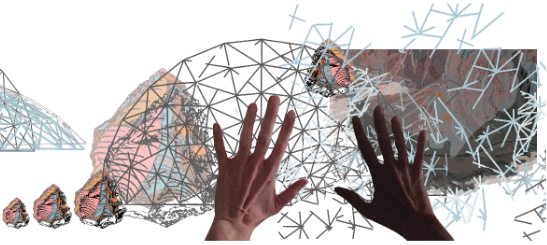
Effective self reflection has enabled me to consider my historical practice and the barriers and blocks I have faced previously. It has also allowed me to find connections between visual practice, my feminist sympathies, and my frustrations at continually finding that my voice does not fit or is not heard. It has enabled me to start making sense of my practice as a whole, instead of separate little parts of me.

I want to draw old machines on old machines. I am making colour palettes in gridded squares of 8 by 8, after Emily Noyes Vanderpoel’s 10 by 10 grids. I am drawing computer hardware from 1978 – 1984. I have deconstructed the film Computer Chess using the female gaze. I will continue investigating redundant technologies, I am looking at acquiring a KolaPad (C64) which when used with appropriate software can be used as a drawing tablet to authentically draw in 8 bit rather than on an emulator.
One of my foremost areas of enquiry is finding or creating a space for my voice. It has been difficult to build on spaces and voices defined by previous female practitioners. I have found it difficult to find a way of speaking that is not understood through a particular way of reading. I have explored painting, I have explored the use of textile and knit, I have explored film and photography. All wonderful vehicles for expression, but not for real communication. The message is interfered by the language of the medium. With painting and film the message struggles alongside the narratives of “feminist painting” or “female film”. Textile and knit as the feminine medium. Therefore, opening up a space for illustration in ‘digital’ or ‘video’ whose narrative is yet to be defined, is very seductive.
My working title is ‘Exploring Video as a platform for the voiceless. To discover if the aphonic can exist in the space of Video’. Or ‘Can video be defined as a language or distinct system of communication?’ The aim of the project is to explore the relatively new space created by video game software as a potential vehicle for illustration and art. Objectives within this aim are to define or understand this space, which I’m referring to as ‘Video’. Understand how to use this space for visual communication. Discover the neutrality, language and politics of the space.
As such the next stages of my practical research began with drawing images of redundant video game technologies. This was to familiarise myself with technology that used 8 bit graphics. The project running alongside these drawings is an investigation into 8 bit colour palettes, therefore it seemed natural whilst undertaking the colour investigation that I draw the machines 8 bit was built for.
This is a selection from a number of images I have made demonstrating part of a research enquiry into redundant technologies. This selection of developmental work contributes towards criteria 2.4 and 2.5 particularly as the drawings demonstrate confident use of media and technical expertise relevant to illustration practice. This is a selection of a series of drawings of redundant video game platforms and personal computers. The relate to each other in terms of subject and technique. The project preceding this was the Computer Chess project where I drew in black and white a number of late 70’s early 80’s computers. In this respect this series follows on from Computer Chess developing the investigation in colour. The project that follows, and runs alongside, this series of drawings is an investigation into 8 bit colour palettes. The link here is with redundant technologies and colour. Out of context the drawings are realistic renderings of old computer technology and could be printed as outcomes. So to a first-time viewer looking at the images they might get a sense of retro gaming, nostalgia, may be joy in the colours, or sadness in the loneliness. The wider research project is not expressed in these images which is why this series is an outcome but also a development project.
‘The Realtime Art Manifesto 12 Years Later’ is the seventh chapter in the book ‘Videogames: Design / Play / Disrupt’ which is the accompanying book of the exhibition at the V&A.[1] I visited the exhibition on the 4th of November this year (2018) and experienced the Realtime Art Manifesto in the context of contemporaries. I am interested in the text as part of my search for spaces or platforms for unheard voices.
Auriea Harvey and Michael Samyn are collaborative artists making art videogames. They launched their Realtime Manifesto[2] in 2006 at the Athens Mediaterra Festival of Art and Technology. The text concerns the pair revisiting their manifesto after twelve years, discussing what has changed. The artists introduce themselves, their background and the Realtime art project. They then proceed to take each declaration in the manifesto and describe and/or analyse the progress made with each statement. They point the reader to the original manifesto online for comparison.
The original Realtime Art manifesto was “a call-to-arms for
creative people (including, but not limited to, video game designers and fine
artists) to embrace this new medium and start realizing its enormous
potential.”[3]
The new medium referred to Realtime 3D as “the most remarkable new creative
technology since oil on canvas”[4]
and “much too important to be wasted on computer games alone.”[5]
The main thrust of the artists work relies on their belief that Realtime 3D is a medium that ought not be limited to the production of video games, and that it should be expanded that fine artists might use it as a space to create work.
Beneath this primary conviction other ideas are proposed and debated in the document which include:
There are a number of unjustified assumptions within the text. In particular a statement that illustrates a binary positioning that sets up Realtime 3D against modern/contemporary ‘art’. “In the high technology of the digital we found a way to reconnect to artistic traditions that had been muffled by the abstraction and conceptualism of Modernism.”[6] The text does not explain this further or elucidate with examples. The artists so not describe how their use of digital technology connects with artistic production previous to Modernism. Furthermore “The synthetic nature of these creations allows us to express our art more directly – as did the early painters – creating a potential for depth that had to some extent been forgotten through the shallowness of photography.”[7] I am not confident I understand what is meant by ‘shallowness’, the text does not specify whether they mean that photography cannot communicate complex concepts, or, by it’s 2D nature photography is shallow and therefore inferior to a digital 3D space.
There is a strong chain of reasoning throughout the chapter. It is with consistency that the artists argue their stance that the strength of Realtime 3D is in audience participation. “A painting on a wall in a museum only turns into an art experience though the activity of the spectator. It is the spectator’s work that animates the piece. The artist merely creates context.”[8] Meaning the value of the piece of work exists in a dialogue between the creator and the receiver, through interaction with the artpiece, and, according to Harvey and Amyn, that interaction between artist and audience is stronger and more relevant in digital 3D form than in other artforms. They describe artwork as the software written by a creator, and warn against considering software as able to think. Moreover, coding software is a “form of human expression. Every algorithm was written by a person. That person carries the responsibility for what is produced by the algorithm.”[9]
The structure of the chapter is interesting as it is based on the structure of a previous manifesto that the pair wrote in 2006. The previous manifesto may have been arranged arbitrarily but as this text uses this previously established structure, then the composition of the chapter is not in itself arbitrary. It seems to be a sensible approach to an analysis of a manifesto. Harvey and Amyn assess their manifesto and describe how they have changed as practitioners over twelve years, and how their context, their political surroundings and the world they live in has changed.
Towards the end of the chapter the artists begin to speak more emotionally about where they see their practice “At this point we feel that it is very difficult to ‘embrace technology’ anymore. What once presented itself as the foothills of paradise has turned into a hell from which no escape can be imagined”.[10] This negative outlook towards the end of the paper describes the artists disillusionment over recent global events and authoritarian politics, and the reemergence of corporate broadcast models.
In terms of the quality of the arguments presented, even though a scholarly article written by practitioners, many of the concepts are based on assumptions and the personal experiences with little corroborating evidence to support the artists statements. More work would be needed by the researcher in order to trust the judgements made in the article.
In terms of the content, the artists write with passion and experience of embarking on a project with much hope to find the once open space of the Internet, through politics and economics now seems confined and managed.
I find the chapter intriguing and want to understand more about
the digital space that Harvy and Amyn describe. I wonder if there is potential
still that can be uncovered. Equally, I find this article biased against recent
art without demonstrating a nuanced understanding of Modernism in all its
various and complex forms. To disregard, or pit against, Modernism seems rather
a problematic and perhaps inapposite exercise.

References:
[1] Various Artists. (2018). Videogames: Design/Play/Disrupt. Exhibited at the The Victoria and Albert Museum, London, September 2018 to February 2019.
[2] Auriea Harvey & Michaël Samyn, Realtime Art Manifesto 2006, Belgium, accessed 19 November 2018, <http://www.tale-of-tales.com/tales/RAM.html>
[6] Harvey, A; Amyn, M,. (2018). ‘The Realtime Art Manifesto 12 Years Later’ in Foulston, M, Volsing K,. (2018). Videogames: Design / Play / Disrupt. London: V&A Publications, pp. 90 – 97.
[7] Ibid
[8] Ibid
[9] Ibid
[10] Ibid
In the first draft of my proposal I set out my interest in exploring the female viewpoint in the film Computer Chess. My interest in this film went further than enjoying the dry wit of this mumlecore comedy. What bothered me was the lack of recognition given to the female role, who is actually the most significant character, or player, in the movie. With further research it appeared that from the filmmaker to the critics, the female role is dismissed. Far from a maguffin or muse, she is the key to the success of the story, she is the hero, the saviour. However, her essential part is seemingly unacknowledged. Because I felt so strongly about this lack of recognition, I made a comicstrip/visual narrative in response. I decided to do this after reading a copy of the journal ‘Beneficial Shock’ which “aims to use illustration … in humorous and irreverent ways to expressively interpret film related content” (www.beneficialshock.com).
These are some of the images from the comicstrip I developed. The strip is eighteen frames long and the text is taken directly from the film script. Using examples of rhetoric from the male characters when they are being particularly boastful and/or sexist. The majority of the images are drawn from film stills with some coloured images of chess pieces and a chess clock.
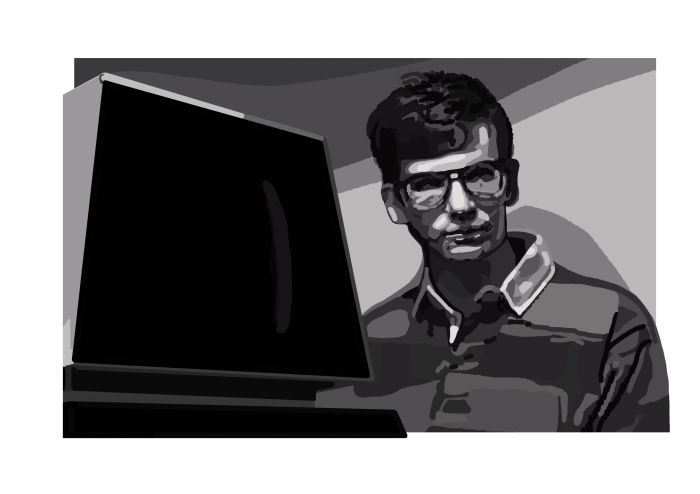

I called the comic ‘Shelly’s Conference’ as it is her experience of the computer chess conference.
Whilst making this comic strip I began thinking about technology in terms of male and female spaces, and then began thinking about the differences between computer hardware and software, and what unexplored spaces there might be. I then began to research the space of computer software as an environment for artistic expression. I came across many interesting ideas including manifestos claiming digital space for the unheard creatives.
One of my foremost areas of enquiry is finding or creating a space for my voice. It has been difficult to build on spaces and voices defined by previous female practitioners. I have found it difficult to find a way of speaking that is not understood through a particular way of reading. I have explored painting, I have explored the use of textile and knit, I have explored film and photography. All wonderful vehicles for expression, but not for real communication. The message is interfered by the language of the medium. With panting and film the message struggles alongside the narratives of “feminist painting” or “female film”. Textile and knit as the feminine medium. Therefore, opening up a space for illustration in ‘digital’ or ‘video’ whose narrative is yet to be defined, is very seductive.
My working title is ‘Exploring Video as a platform for the voiceless. To discover if the aphonic can exist in the space of Video’. Or ‘Can video be defined as a language or distinct system of communication?’ The aim of the project is to explore the relatively new space created by video game software as a potential vehicle for illustration and art. Objectives within this aim are to define or understand this space, which I’m referring to as ‘Video’. Understand how to use this space for visual communication. Discover the neutrality, language and politics of the space.
As such the next stages of my practical research began with drawing images of redundant video game technologies. A selection from a number of images I have made:
Alongside drawing these consoles and computers, I am also investigating how to use redundant technologies as a medium for drawing. There are USB attachments that can be used to enable C64 machines improve the range of user interfaces and to increase speed and memory. Also there is a new version of Atari 2600, in a mini and planned full size model, with digital drawing programs and wireless interfaces. I have begun exploring the potential of 8 bit grids as a structure for illustration.
Grids have been a theme for me during my creative career, beginning when studying painting at Winchester School of Art, through exploring knit, and in storyboarding for film.I have a background rooted in the writings of Krauss and Barthes, semiotics, post-structuralism and grids as visual languages. So it is not a surprise to me that grids are significant in these early stages of research. Chess relies on a grid, the visual narrative/comic in response to Computer Chess is a grid. Pixels are a grid and drawing in bytes uses a grid.
Recently I backed a Kickstarter campaign to re-print an early work by Emily Noyes Vanderpoel. I had not been aware of her before, however colour investigations and descriptions of objects, communicated through a 10×10 grid are fascinating to me (fig.1). Another practitioner new to me is Lorena Lohr, an American photographer who uses old film point and shoot cameras to document the drab realities of life as she travels around the southern states (fig.2).
(fig.1) Emily Noyes VanderPoel, (1901) Plate LVIII, The Circadian Press, accessed 05.01.2019 ‘www.sacredbonesrecords.com/products/emily-noyes-vanderpoel-color-problem’
(fig.2) Lorena Lohr, (2016) Untitled Downtown el Paso 2, accessed 05.01.2019 ‘www.lorenalohr.com’
Inspired by Noyes Vanderpoel colour grids, I began making colour palettes of Lohr’s photographs. I changed the grid to 8×8, 64 squares, to be in line with drawing in bytes. Here are some sketchbook pages working through this process.
I continued to make these colour palettes and included works by Agnes Martin and Wayne Thiebaud in the experiment.
With colour palettes and drawing redundant technology, however I am planning the next steps. I am in the midst of setting up a Commodore 64 console with old TV screen and have acquired a copy of original C64 drawing software and a Trojan screen drawing pen. Next I will be beginning an experimental journey into 8 bit drawing.
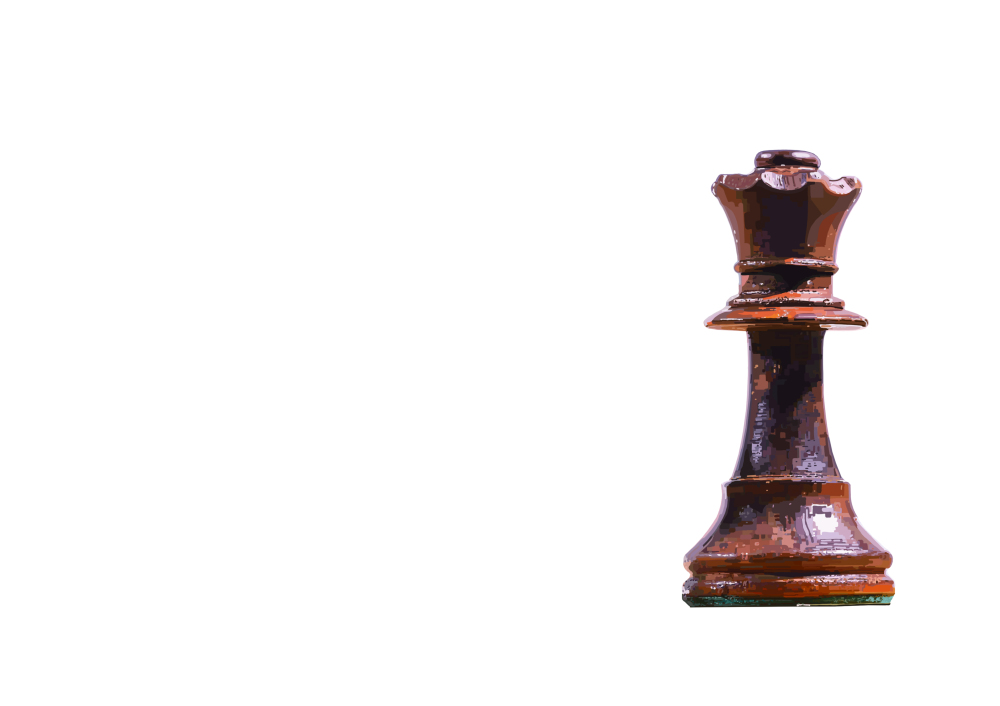
I’ve watched the film ‘Computer Chess‘ many times. Released in 2013 and directed by Andrew Bujalski, it is shot in black & white analogue. The film documents a conference held in a hotel over a weekend sometime between 1981 and 1983. The conference is to debate the potential of artificial intelligence beating a grand master at chess. Various groups of programmers and their computers then spend the rest of the weekend in a computer chess tournament against each other.
“Set over the course of a weekend tournament for chess software programmers thirty-some years ago, COMPUTER CHESS transports viewers to a nostalgic moment when the contest between technology and the human spirit seemed a little more up for grabs. We get to know the eccentric geniuses possessed of the vision to teach a metal box to defeat man, literally, at his own game, laying the groundwork for artificial intelligence as we know it and will come to know it in the future.” – (Andrew Bujalski, accessed 13.12.2018 www.computerchessmovie.com/aboutthemovie.html)
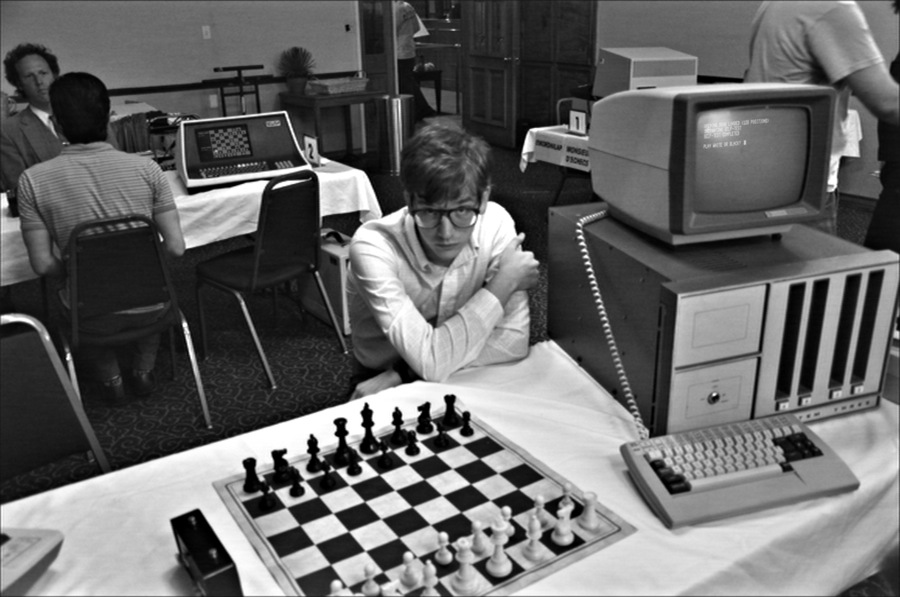
There is one female engineer, Shelly Flintic, who is the character that has the knowledge and skills to create the artificial intelligence the male engineers are so concerned with. However, her voice or viewpoint does not feature with any significance. This bothered me more with each viewing so I decided to redress the balance.
Taking some inspiration from ‘Beneficial Shock‘ a magazine that aims to interpret film through illustration, I prepared to make a visual narrative or ‘comic’ of the film to tell Shelly’s story. Using stills from the film, I drew a number of images. From these images I selected those that worked together to form a narrative or sorts. I read the film script and chose sections of dialogue that seemed particularly sexist or uncomfortable. The following image illustrate this process.

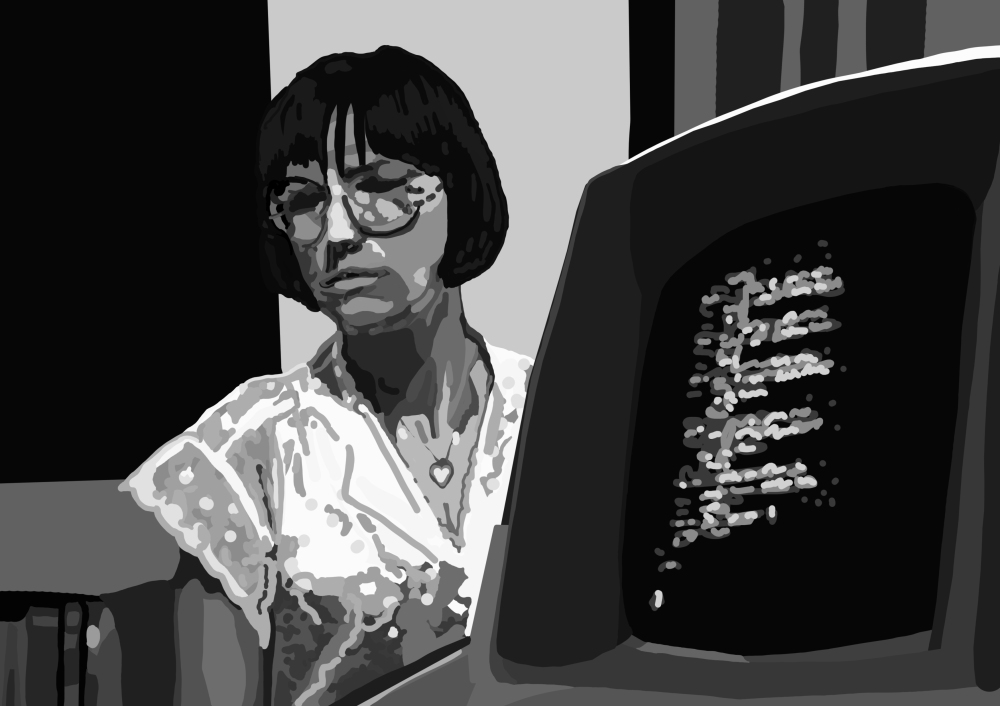

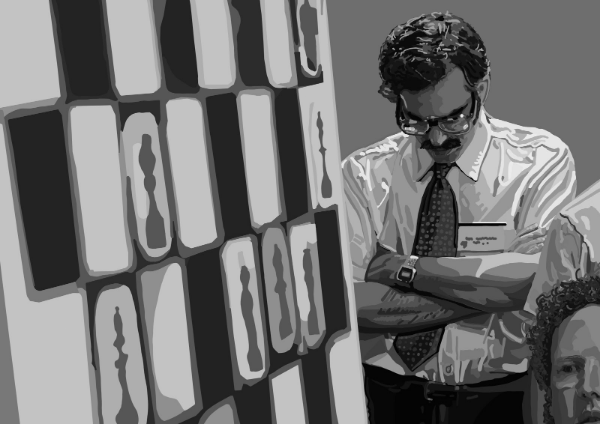

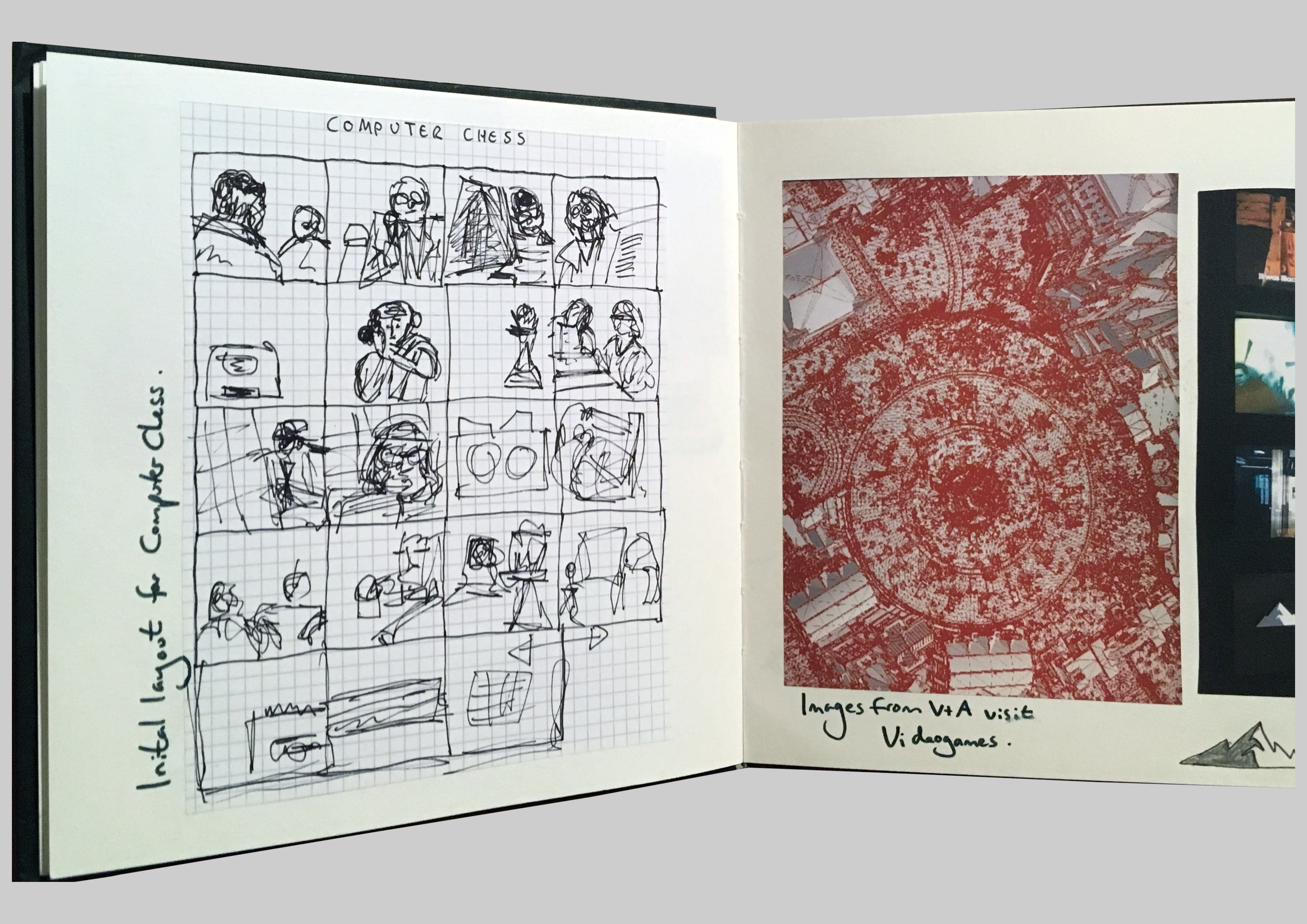
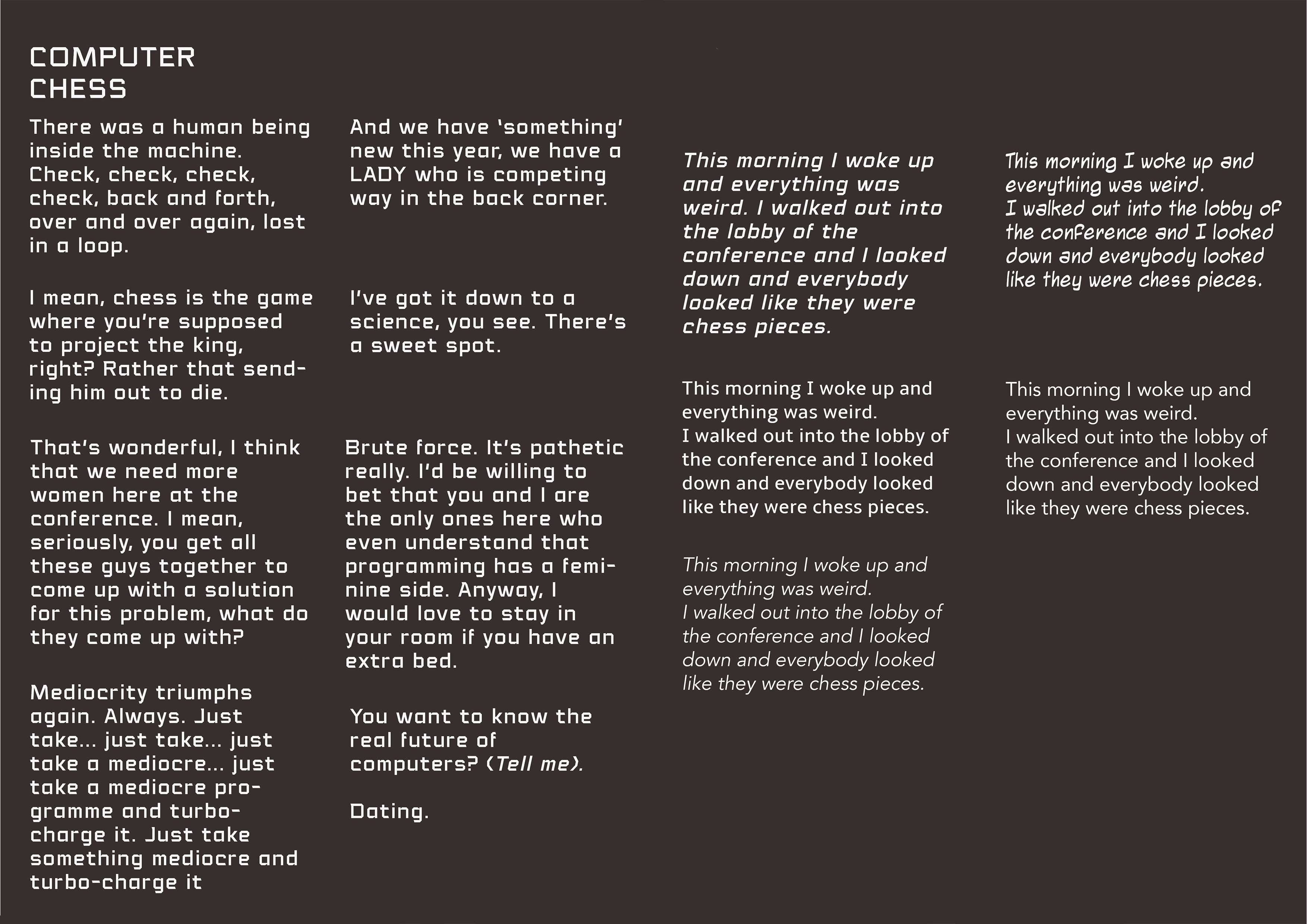
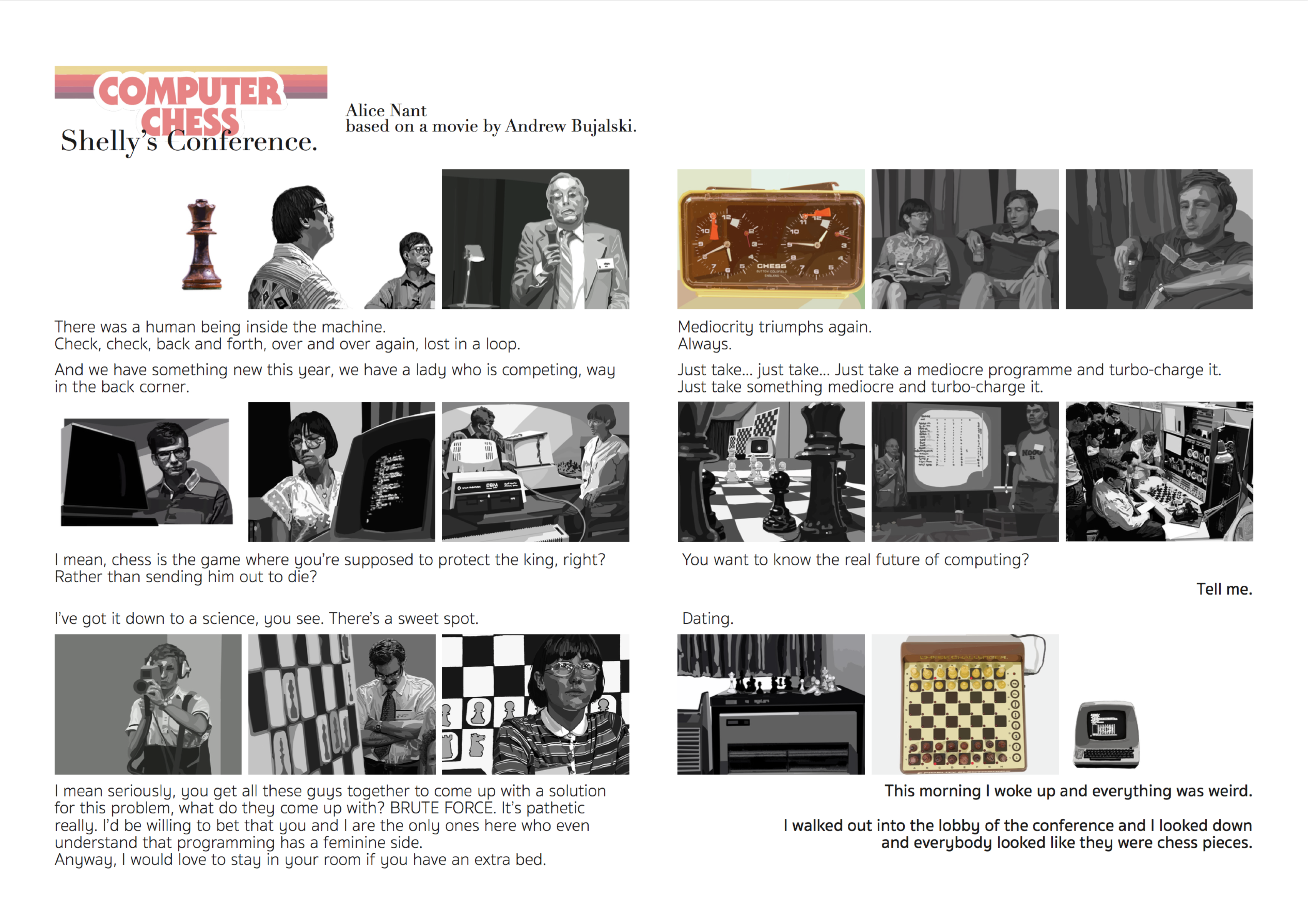
References:
Website for the magazine ‘Beneficial Shock’: www.beneficialshock.com
Website for the film ‘Computer Chess’: www.computerchessmovie.com


Emily Noyes Vanderpoel at home (www.sacredbonesrecords.com/collections/emily-noyes-vanderpoel)
Emily Noyes Vanderpoel (1842-1939) is a largely overlooked artist and writer. Her first book Color Problems, A Practical Manual for the Lay Student of Color was first published in 1901. It contained beautiful diagrams to describe the science of colour theory, and charted objects she deconstructed using colour analysis.
She deployed ‘the Grid’ long before it became a stage for formalism. I am interested in her forgotten voice and her early use of the grid as a method of studying colour as visual language. The extent of her influence on early modernist aesthetics is unknown and the reprinting of her first book by The Circadian Press with Sacred Bones Books is an attempt to instate Vanderpoel as a visionary who influenced minimalism and formalism.
Vanderpoel used a grid of one hundred squares to analyse the colour of objects. Inspired by her method of charting colour and my interest in drawing in 8 bit I am interested in making some colour analyses in grids of 64 squares, 8 by 8..
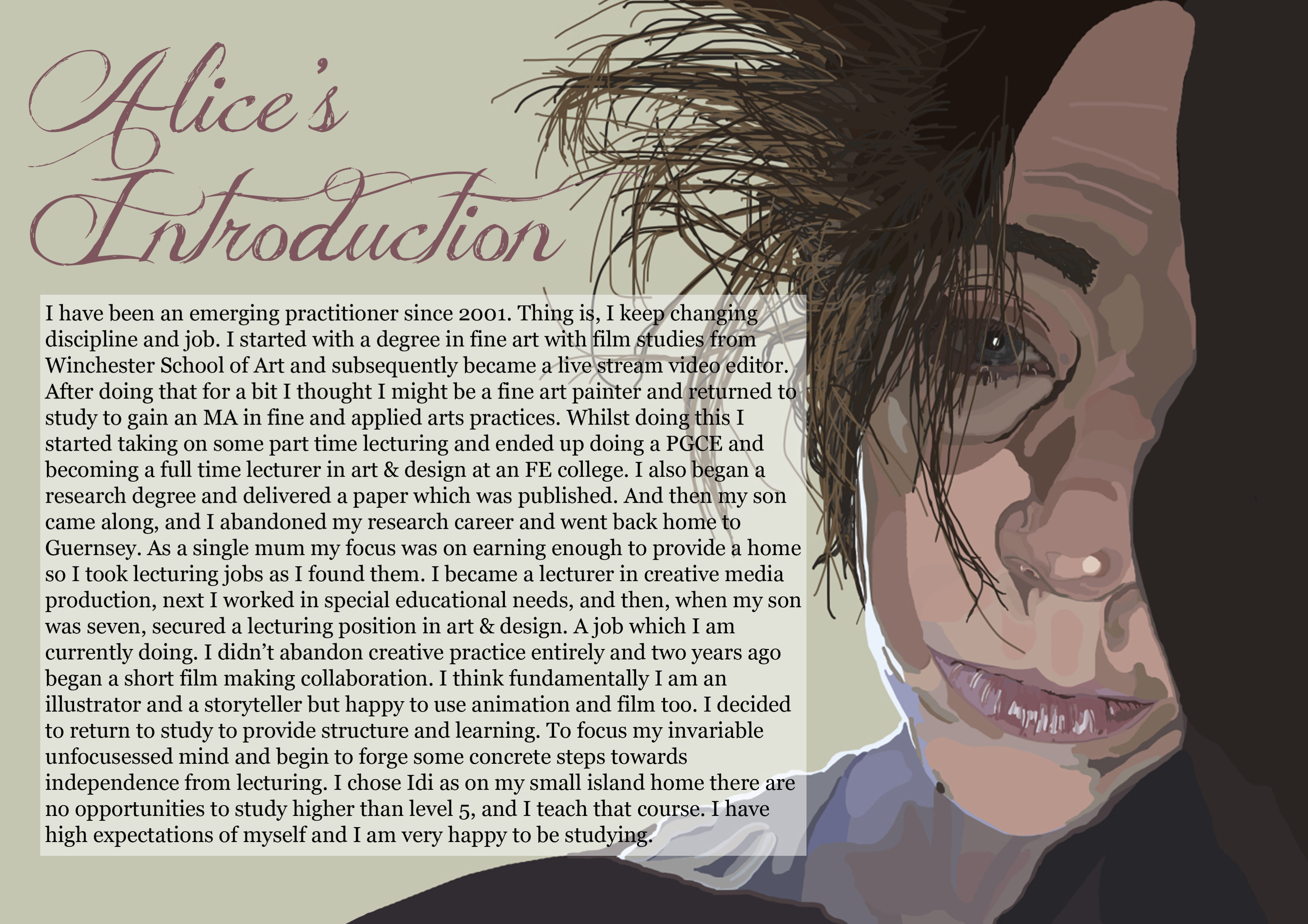


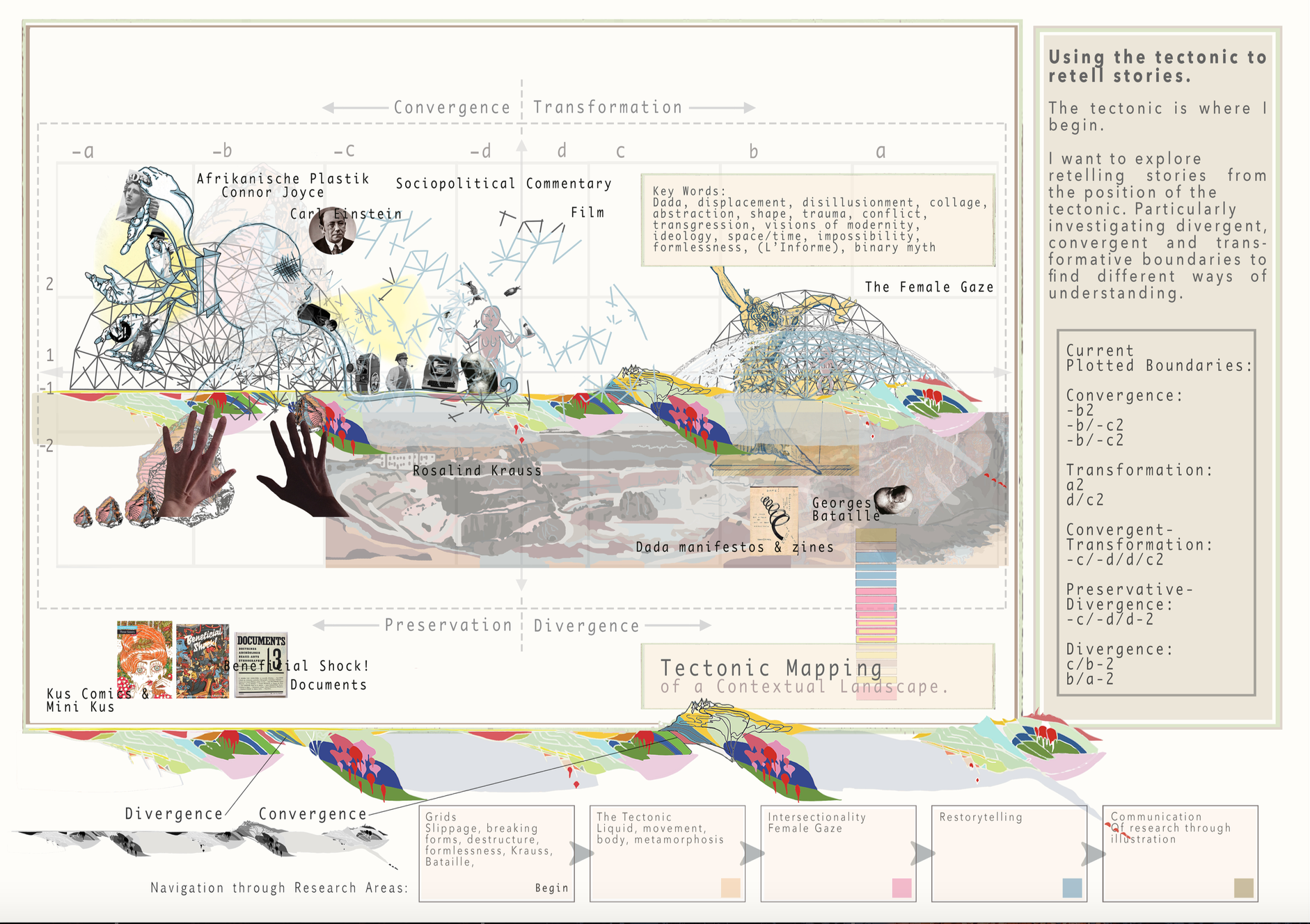

Project Context
I like visual journals, graphic narratives, comics, illustrations, stories, and film. I make films, I draw, use hand printmaking techniques, develop photographic imagery. I seem to need to combine, twist, break and fix images. This is my visual language and method of production. My context is one of feeling, being, voiceless. Working often in collaborations, not feeling I have the space to tell the stories I want to tell, the stories I feel need telling. I think this journey I have begun is about finding, negotiating and staking claim to a space in which my voice can exist. I am starting this exploration in a tectonic space, a fluid space.
Project Outcome
A probable and quickly realisable outcome for this project is retelling stories from the viewpoint of traditionally female roles. For instance, in the film Computer Chess1, the female characters are typically a receptionist, a hooker, a middle aged swinger/predator, a mother with baby and, a computer engineer, the first woman to ever enter the computer chess tournament.
Documented perspectives of the film include:
Project Manifesto
As for a manifesto, I don’t believe I am ready yet to write this. I do know however what it is not. This is not my manifesto:
Shooting must be done on location. Props and sets must not be brought in (if a particular prop is necessary for the story, a location must be chosen where this prop is to be found). The sound must never be produced apart from the images or vice versa. (Music must not be used unless it occurs where the scene is being shot.) The camera must be hand-held. Any movement or immobility attainable in the hand is permitted. The film must be in color. Special lighting is not acceptable. (If there is too little light for exposure the scene must be cut or a single lamp be attached to the camera.) Optical work and filters are forbidden. The film must not contain superficial action. (Murders, weapons, etc. must not occur.) Temporal and geographical alienation are forbidden. (That is to say that the film takes place here and now.) Genre movies are not acceptable. The film format must be Academy 35 mm. The director must not be credited. Furthermore I swear as a director to refrain from personal taste! I am no longer an artist. I swear to refrain from creating a “work”, as I regard the instant as more important than the whole. My supreme goal is to force the truth out of my characters and settings. I swear to do so by all the means available and at the cost of any good taste and any aesthetic considerations. Thus I make my VOW OF CHASTITY. Copenhagen, Monday 13 March 1995 On behalf of DOGMA 95 Lars von Trier & Thomas Vinterberg.(4)
References:
Primary and experiential research has a direct and sometimes immediate impact on practice and the direction of a project. Secondary research, learning from journals, books, recorded interviews and films helps to extend thinking and to form links and connections between pools of thinking and isolated theoretical understanding. These links are important because originality of thought, comprehension and production often comes from these individual connections. Secondary research might not have such immediate impact on practice but helps mould a project and shape future work by enabling critical evaluative judgement of individual practical work. Secondary research is vital to understanding current practitioners and previous historical practical and theoretical work. A combination of primary and secondary research is essential to critically understand individual practice. Ensuring the currency and validity of produced work and the awareness of place within a wider creative world.
The following text outlines the processes and methodologies of research that are important to my individual practice.
Visiting exhibitions and analysing the impact and relevance to personal practice is an important research tool. Living remotely I visit France once and the UK once or twice a year. Luckily Guernsey has a dedicated Museum and Art Gallery, and Art Commission, which, although provincial in many ways, does secure interesting and international exhibits. The most recent exhibitions I have attended in Guernsey include ‘Visions of Exile’(1) showing drawings and illustrations by Victor Hugo, and various events at the Guernsey Photography Festival, in particular the exhibition, ‘Mars: A photographic Exploration’(2) which was a display of cropped monochrome photographs from NASA’s Mars probe, curated by Xavier Barral. During my recent visit to London I saw ‘Videogames: Design/Play/Disrupt’(3) at the V&A. Visiting current exhibitions allows awareness of of issues and debates in creative practice and theory.
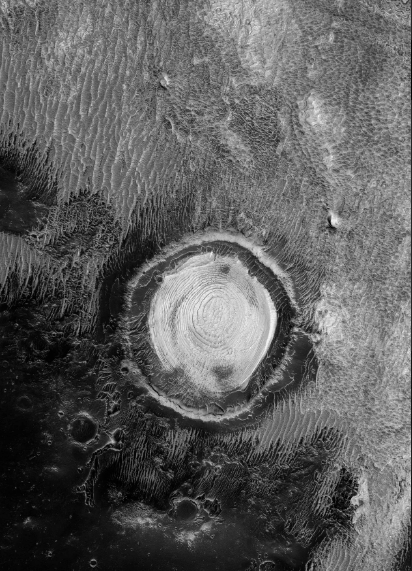
Substantial research material can be accessed online through organisations such as the ICA (www.ICA.art), V&A online archives (www.vam.ac.uk/info/archive-of-art-and-design) and National Art Library (www.vam.ac.uk/info/national-art-library/) and the British Library online services (www.bl.uk/learning/online-resources). Conferences can also be incredibly rewarding in terms of research development, fortunately transcripts or recordings are often available online. As are research and practitioner groups such as JISC Mail (www.Jiscmail.ac.uk) web forums and e-groups for example: Art Technology, Design-Fiction, Digitalcomics, Enquire, Pass, Cas. Other online research groups and discussion forums include, the ICA Social Creative Network (www.ica.art/learning/scn), CRATE Collaborative Research Group (www.cratespace.co.uk/CRG) and Lemon 64.(www.lemon64.com/forum/)
Being aware of relevant practitioners in and apart from the discipline is incredibly important. Studying the visual language of others helps embed and develop individual visual language and critical process.

My visual research takes place through sketches, photography and film as part of continuous practice and review. One strand I will be experimenting with will be grids as a structure for drawing, I intend to investigate the potential redundant technologies as a medium for illustration. Old 8 bit machines can be connected with various USB interfaces and with downloadable software, can be modified into drawing machines. Also using freeware 8 bit drawing programmes such as Multipaint (multipaint.kameli.net/), Pixel Polizei (www.kameli.net/marq/?page_id=4557) or with the PETSCII Editor (www.kameli.net/marq/?page_id=2717) standard drawing software, files can be converted into load ready for C64 or Atari. These processes will provide a defined structural digital grid to work within. Alongside this investigation I will continue making work in series, illustrating theoretical research and thinking. Of course fundamental to research and practice is keeping a sketchbook of drawings, found images and collected items. A sketchbook is one of the most helpful devices to track progress and development.

Both primary and secondary research, and their combination, contributes to the progression and growth of individual practice.
References:

How would you define your practice in relation to the notion of practice as research, practice-based and practice-led research?
I would define my practice as practice-led. This is because theoretical and academic research is prompted by the practical work I make. Then from the theoretical investigation more practical work will be made, which in turn prompts further theoretical and contextual research. For instance in the first instance of my proposal I was interested in exploring the female viewpoint in the film Computer Chess (1), what interested me was the significance of the female role, who does not receive equal acknowledgment or recognition. From further research it appeared that from the filmmaker to the critics, the female role is dismissed, but to me she was the most important and striking character. I made a comicstrip in response. Whilst reviewing and analysing the value of the comic strip I undertook further research into the space of computer software as an environment for artistic expression, and from this investigation further practical work is being made. The practice leads, but the theoretical and contextual research is of equal importance, and happens alongside the practice.
It is believed that artistic research processes are often iterative or cyclic. Do you agree? What is your understanding of the iterative cyclic web model illustrated in the introduction to ‘Smith, H. & Dean, R. (2009) Practice-led Research, Research-led Practice in the Creative Arts’?
Artistic research processes are iterative. The process moves through a series of steps, the beginning of new work builds on the knowledge uncovered by the previous work. It is a progressive and moving process. This diagram is from Smith and Dean Practice-led Research, Research-led Practice in the Creative Arts:

The following diagram is based on the Smith and Dean diagram but is easier to read:

It shows that, as ideas are generated, research and practice are initiated, in conjunction. Various types of output, practical and academic, are produced during the process, which led to further ideas generation and the process begins again.
How is a given methodology relevant to your own research proposal?
I feel the most appropriate methodology to apply to my research proposal is Grounded Theory. The generation of theory from data. Or, the generation of theory from practical work. “Having analysed a batch of data, the researcher returns to the field for more data, traced with the insights provided by previous analyses. Data are coded, conceptual labels honed and theoretical categories constructed. As the point of “saturation” of categories is approached, data collection gives way to defining and conceptual refinement.” (2) I feel that Grounded Theory reflects the iterative process described by Smith and Dean. The construction of side by side categories of research and work, the combination of which suggests conclusions and theories, from which more categories are derived.
One methodology or more methodologies? Would you use multiple methodologies in your research? Why?
I would use more than one methodology in my research. Methodologies are project dependant and various types of data may need collecting. The most relevant methodologies to my current work, alongside Grounded Theory, include Case Studies, and Feminist Perspectives. In particular case studies that involve investigating and discovering practitioners, theorists, ideologies and politics. Visiting and recording experiences of exhibitions, conferences and museums. The importance of Feminist Perspectives are a consideration because a main enquiry of my work is finding or creating a space for my voice. It has been difficult to build on spaces and voices defined by previous practitioners that are not male, difficult to find a way of speaking that is not understood through a particular way of reading. A way of reading that is not how I need to be understood.
I use more than one methodology. Multiple methodologies enable discovery and understanding from multiple perspectives. Multiple methodologies enable a deeper level of insight.
References:
1 Bujalski, A., Computer Chess . (2013). USA: Houston King, Alex Lipschultz.
2 Koneki, T., (2011). Visual Grounded Theory: A Methodological Outline and Examples from Empirical Work.A vailableat https://hrcak.srce.hr/file/106256 [Accessed29.11.2018].

This is my attempt to create diagrams to explain the relationship of theoretical research and practical making in conjunction with the process of the creative cycle.

A ‘Klein 4 group’ diagram is where three of the elements in the group, produce the fourth element. Krauss used this digram to plot sculpture. Her group of four elements consisted of ‘landscape, architecture, not-landscape and not- architecture’. She intimated that this closed group was Structuralist, or Modernist. Krauss then ‘expanded’ this group to add, on the diagonal, the elements marked sites, site-construction, axiomatic structures and sculpture. She did this to demonstrate how sculpture (in the 1970’s) positioned itself against landscape and architecture. This expanded diagram, or ‘the expanded field’, was defined by Krauss as Post-structuralist, or Post-Modern.

I used Krauss’ expanded diagram to attempt to describe the creative process. Using her term axiomatic, or fixed, and idiomatic to suggest natural and fluid. These are the elements in the square, fixed (axiomatic), not fixed (not axiomatic), fluid (idiomatic) and not fluid (not idiomatic). expanding this 4 group I have put the elements of the creative cycle problem (question or brief), analysis (development and research), solution (outcome) and synthesis (review and development). Suggesting that the problem, or brief, is fixed and not fixed, the analysis, development and research is both fixed and fluid, the solution is fluid and not fluid – opposite to the brief, and the synthesis, or evaluative process, is both fluid and fixed.


I made another diagram to explain the creative process, using this time a CREEK diagram, or at least part of one. Taking the existential plane of the individual I inserted a 4 group to illustrate the creative cycle, and then made the hermeneutic plane a vertical intersecting plane to demonstrate that research going in and practical work going out is interpretive but not in opposition to the existential plane. So the research and outcome input and output) travels through the middle of the individual navigating the creative cycle.

Event: Hugo, Visions of Exile – Location: Guernsey Museum at Candie 22 June 2018 – 16 September 2018
Event Website: www.museums.gov.gg/article/157853/Hugo-Visions-of-Exile
Exhibition Rationale: “Victor Hugo’s writings are known throughout the world. Novels such as Les Misérables and The Hunchback of Notre Dame made him a legend in his own lifetime. What many people are not aware of is his skill as an artist. He produced over 3,000 drawings, mostly using the very ink he would write his novels and poetry with. As well as being an extraordinary draughtsman Hugo was fearlessly experimental in his drawings. Added to the ink would be coffee grounds and soot, as well as imprints of lace and stencils. The intensity and emotion in these drawings grew during Hugo’s exile in the Channel Islands. First in Jersey between 1852 and 1855, and then moving to Guernsey where he lived at his home, Hauteville House, until 1870.” (https://www.visitguernsey.com/event/hugo-visions-exile)
“The exhibition ‘Visions of Exile’ at Guernsey Museum displays many of these groundbreaking drawings which were kept hidden from public gaze by Hugo, sharing only with his family and friends. The drawings have been generously loaned to the Museum from two major French institutions, Maisons de Victor Hugo and the Bibliothèque nationale de France and supported by Canaccord.”(https://www.visitguernsey.com/event/hugo-visions-exile)
Date and time of my visit: Thursday 16th August 2018 at 1pm
The exhibition of Victor Hugo’s drawings is held within the Guernsey Museum. The museum is a building with six gallery spaces, one learning room (the Discovery Room), a lecture theatre with capacity for 66 people, a cafe and a museum gift shop. Entrance to the exhibits is through the gift shop, the cafe can be accessed separately. Four of the gallery spaces hold permanent exhibitions showing (1) archeological finds and information about early man in Guernsey, (2) Guernsey witchcraft and folklore, (3) treasures donated from benefactors that lived locally, (5) and a fine art (painting) exhibit with around 200 paintings mainly from local artists dating from classical to contemporary. There are also a small amount of works on loan, currently a Damien Hirst and a Yayoi Kusama. The remaining galleries hold temporary exhibits. All these spaces interlink and it would be difficult to go into one exhibit without attention being drawn to other rooms.
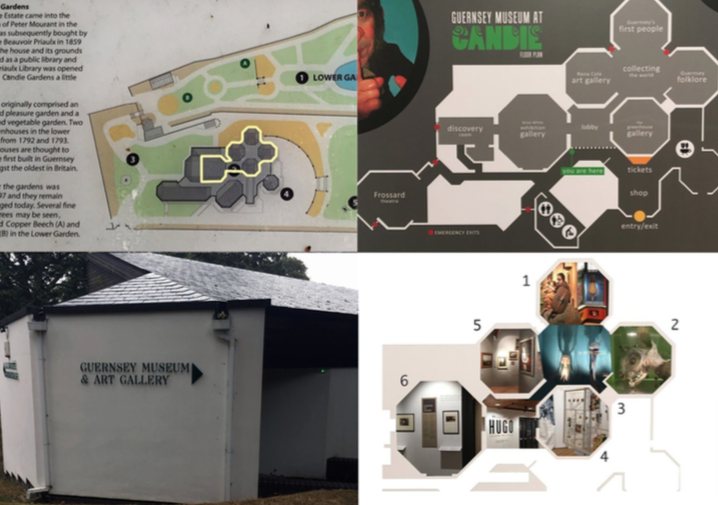
Because it is almost impossible not to look at this eclectic collection of the most weird and wonderful it would be difficult to separate this out from the experience of seeing the Hugo drawings. Particularly taxidermy, there are a lot of stuffed birds which creates a definite Hitchcock vibe to one particular corner. Bits of rusty machine parts left by the Germans when they left in 1945, a skip that was used to renovate an old monument on the common. A miniature of a restoration gentleman. Some old religious relics and a gold covered bible, and the mummified cats often found in the walls of old houses (witchcraft). A spell book and a live stream video installation.
This was my introduction to the Hugo exhibition, and I entered the gallery of illustrations with a mind full of witchcraft, WW2 invasion stories, ancient peoples and monuments and stuffed birds. A particularly dark mindset to adopt before entering the exhibition I had come to see.

Also in my mind was the marketing and advertising for the show that I had researched just before going to the exhibition. These images have been on the side of busses and in local magazines and newspapers. The story of the drawings arriving in Guernsey were reported on the local news. The world’s largest private yacht visited Guernsey from Norway with cruise passengers and a special cruise passenger event was organised. There was an international conference and youtube clips showing researchers talking about the importance of the Hugo works. A private view organised by the show sponsor, the private offshore bank Canaccord Genuity Wealth Management, which was a well documented affair. So I was also mindful of this summer’s hype and aware that I viewed this quite negatively and did not want this to affect my experience of the exhibition.

Entering the gallery I was overwhelmed by how dark it was. These are some photos of the lighting. It was more than subdued, it was dark. The room was lit from spots suspended from the roof which created dramatic pockets of light. The shape of the room is octagonal with two entrance/exit doors which are on opposite walls. The other six walls were display walls and had been painted white. Within the room were a number tall wide temporary walls that were painted brown which can only have helped to darken the space. These walls created smaller display spaces within the octagon, but this also created barriers, small dark booths, sharp corners and some difficulties navigating the room. There was no natural light in the space and the air conditioning had made the temperature cool. It had been raining on my walk to the gallery so my damp clothes, combined with the ambient temperature, made me chilly. There were no specific exhibition sounds or presentations running, the only sounds were of other visitors to the gallery. There were around twelve other visitors to the exhibition which made the space quite crowded and occasionally made it difficult to view some of the work on show.
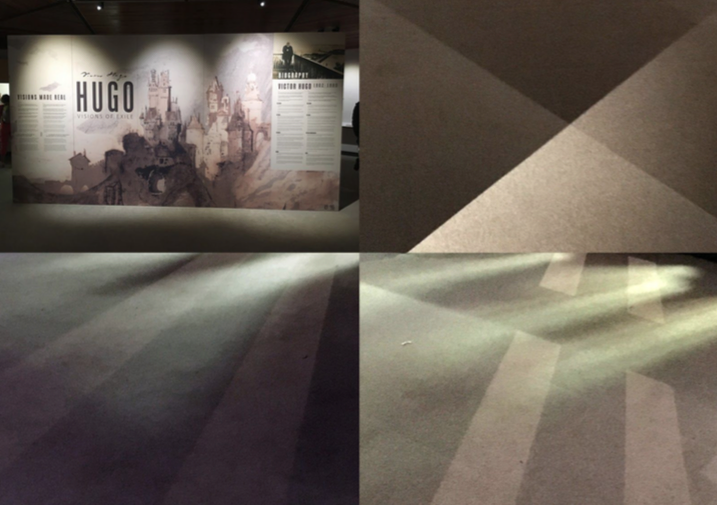
This link is to the exhibition catalogue: http://www.museums.gov.gg/CHttpHandler.ashx?id=114610&p=0

In terms of a local bank sponsored exhibition the show was pleasingly well put together. The drawings had been grouped in context, for instance political cartoons, pictures of the sea, Toilers of the Sea illustrations, Jersey landscapes, Guernsey landscapes amongst others. There were also many drawings on show that illustrated the a breadth of work from whimsical sketches and material tests to draftsman like drawings of ships. It was certainly a comprehensive retrospective. The curators made use of all the space had to offer, and instead of trying to brighten the sunlight less space, they darkened it for atmosphere. The lighting definitely set the tone for the exhibition and I think intended to quieten and unnerve the visitors. The exhibition is a success in that it achieved what it et out to do, which was to showcase the drawings of Victor Hugo and highlight his skills as a visual artist.
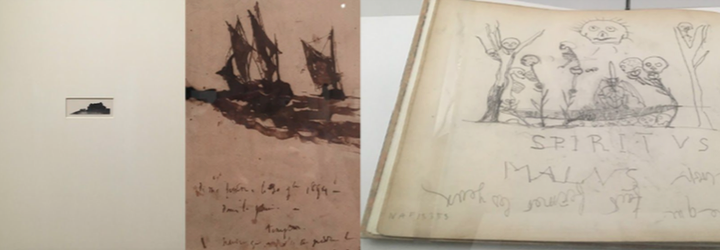
What was a little alarming was the claim that Victor Hugo was an abstract artist before abstraction existed.
“Hugo would use … paper folding techniques … creating ink marked mirror images, as well as applying random ink marks (taches) using various unconventional methods. Hugo used these blots and accidental marks within many of his landscapes from the 1840s, but it was during his exile that he allowed many of the marks to remain unaltered. Hugo did not feel the need to incorporate these taches and stains into recognisable forms but allowed them just to ‘be’, creating abstraction in its purest form.” (Excerpt from the Exhibition Catalogue: http://www.museums.gov.gg/CHttpHandler.ashx?id=114610&p=0)
I looked into this a little to see if there was any research to validate the claim and I found an interesting article from the Tate in 2011 which mentions Hugo’s use of mark making during seances with ouija boards and a pencil to make continuous line drawings while in contact with the dead including his daughter, Galileo, Voltaire, Moses, Christ and Death, amongst others. The article goes on to say that he used this free mark making whilst in exile in the Channel Islands and incorporated them into his figurative landscape and character drawings. Andre Breton had an affair with Hugo’s granddaughter who introduced him to these pictures and he shared them with the Surrealists as they were interest in automatic drawing. Breton is quoted as saying, “‘Victor Hugo is a Surrealist when he is not stupid,” as the Surrealists could not abide his writing and went on to say the Hugo’s seances were “productions… of astounding naivete”. ( Turner, C, The Deliberate Accident in Art – Blots, Tate Etc. Issue 21: Spring 2011, 01.01.2011 https://www.tate.org.uk/context-comment/articles/deliberate-accident-art)
I think I was correct to trust my instinct to be cautious about a statement suggesting Hugo is an abstract artist ‘before abstraction’.

“Smile, it increases your face value.”
Dolly Parton as Truvy Jones.
Steel Magnolias, directed by Herbert Ross (1988; Louisiana, USA: Tristar Pictures, 1989)